|
Want a guided tour?
Navigating
a changing world —
a world in PROFOUND transition
Knowledge THE resource
“We live in a period of PROFOUND TRANSITION
and the changes
are more radical perhaps
than even those that ushered in
the “Second Industrial Revolution”
of the middle of the 19th century,
or the structural changes triggered by
the Great Depression
and the Second World War. …
…
For in many cases … the new realities and their demands
require a REVERSAL of policies
that have worked well for the last century
and, even more, a change in the MINDSET of
organizations as well as of individuals.” — Peter Drucker
Examples: News ::: 1, 2, 3, 4, 5, 6 …
Navigating implies looking for temporary “destinations” or “horizons”
to work toward
or it may be more useful to think in terms of “working toward”
the kinds of work to do
that leads to where you want to go OR avoid …
Organizations not immortal ::: Need to balance
continuity and change ::: Repeated substantial change and massive rethinking
of the very concepts on which they are based — more in Drucker on Asia
“Increasingly, organizations will have to plan abandonment
rather than try to prolong the life
of a successful policy: practice, or product — … only a few
large Japanese companies have faced up to” — “constant change” in PCS
Knowledge THE resource

We can only work on, with and toward the “things”
on our active “mental radar.”
A changing world means we need a way
to see and work beyond current mental involvements
What are the evolving needs of knowledge workers,
knowledge executives, or future leaders?
When is there enough?
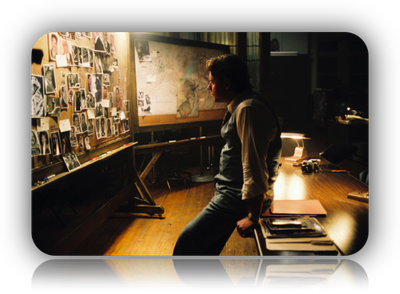
Just reading is not enough
Thinking along a brainroad
Getting back to now
Helping others
Who should have access to this site?
And do you want it to remain available
when something happens to me?
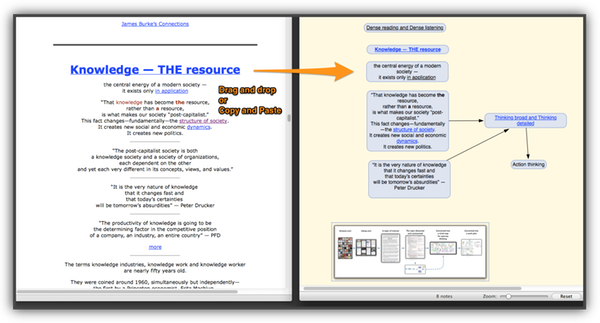
Larger view of image above. Thought collector and idea mapping
Calendarization (working something out in time)
The actual results of action are not predictable
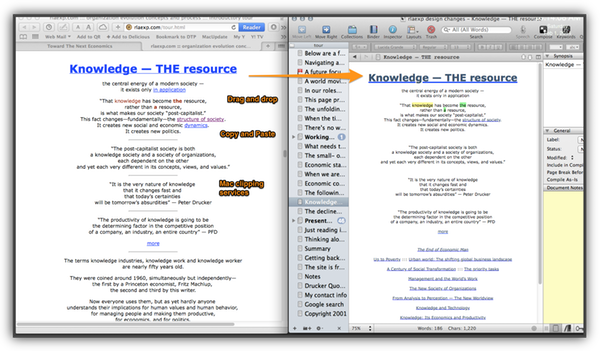
Larger view of image above
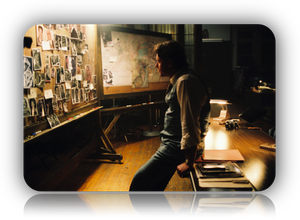
Organization actions: creating change to abandonment

This page provides
a big picture, thinking landscape for
working through time …
A “brainscape” for thinking about the work ahead of us …
It contains radar blips
for directing attention toward the road ahead …

“AS WE ADVANCE deeper into the knowledge economy” — PFD
Technology Is Wiping Out Companies Faster than Ever
Different THOUGHTS for different times … and then do it again

“We know only two things about the future.
It cannot be known.
It will be different from what exists now and from what we now expect”
Peter Drucker — Chapter 10 Management, Revised Edition
“The ultimate test is not to be able to survive and
to be able to cope with change as a threat.
The ultimate test of management is the ability to
make change serve the mission of the enterprise —
to manage change as an opportunity” — PFD
We can only work on, with and toward the “things”
on our active “mental radar”
at a point in time
Connecting the dots
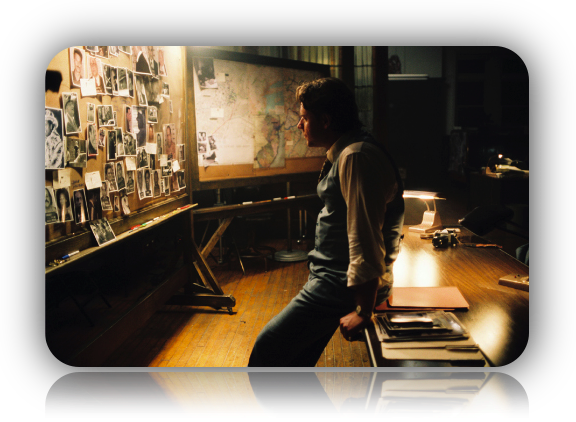

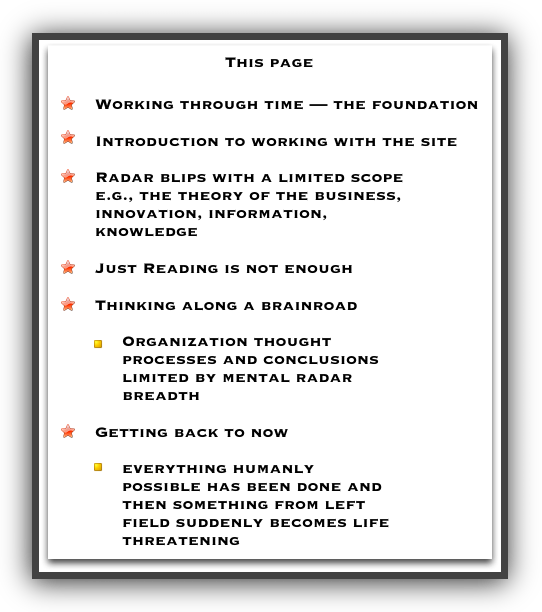
Knowledge exists only in application :::
Base your strategy on the situation, not on a formula ::: What everyone knows
is frequently wrong ::: Using ignorance to your advantage ::: Assumptions ... ::: Today
perceptiveness is more important than analysis …

A world moving toward unimagined futures
Citynoise.org
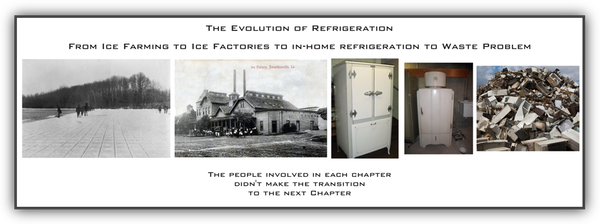
In a growing economy, things should get easier — right?
Mission ::: Continuity and Change

October 16th, 2003 — “Hell Froze Over.” Apple launched – iTunes for Windows.
That opened up the iPod to the 97% of people who had PCs.
Their first iPods turned into their first iPhones
… switched to a Macintosh all together
… along the way Apple’s market cap climbed to
the most valuable company in the world …
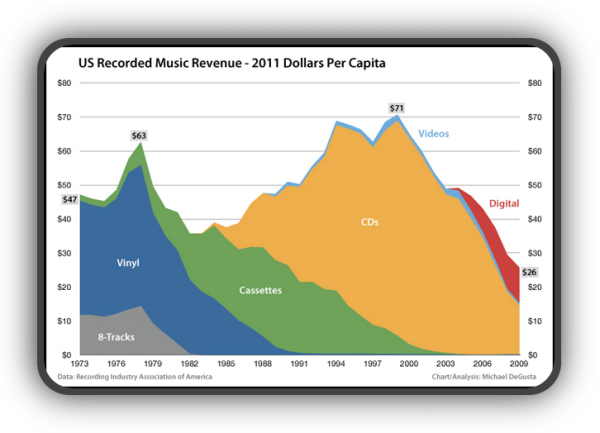
Film to Point-and-shoot to Smartphones
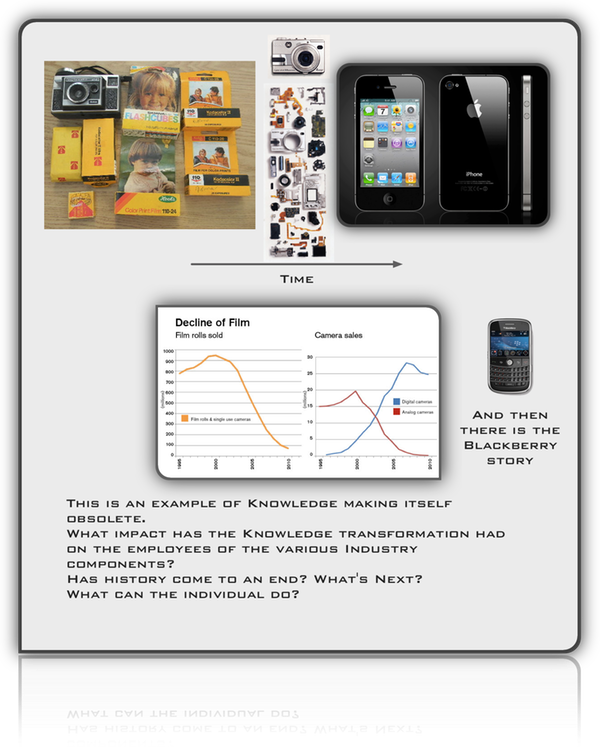
“Twelve cell phones that changed the world”

Intelligent Machines and Displaced Workers

YouTube
Europe: 1000 years in 10 minutes and
World History (3000 BC - 2013 AD)
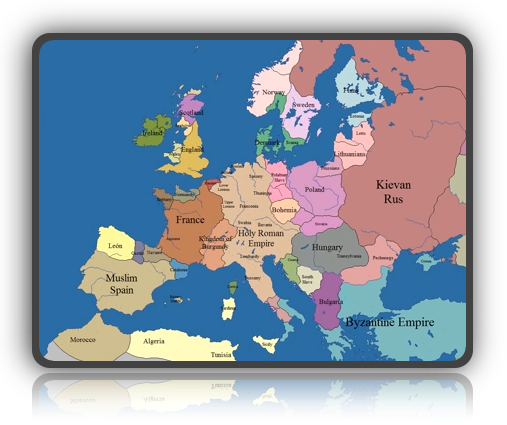
Strategy — The New Certainties #5
A view of economic content and structure
The patterns evident in the images above
exist in almost every area of the economy and society
“The world” is moving away from yesterdayS (1950, 1970, 1990 …)
The transformation
If you investigate the life story of any prominent organization
you’ll likely see multiple chapters in their story.
In some cases there are multiple stories with multiple chapters.
Cases: MRE and Chapter 13, here
From a long-term standpoint, what is the nature
of opportunities associated with new stories (stages)?
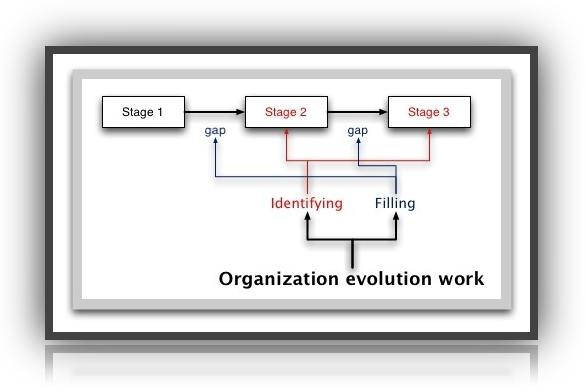
In some cases they started the next chapter early enough
and in others they waited for a near deadly crisis — they
were busy working on other things.
“Today’s executives are, of course, a good deal more
than passive custodians of the past.
They can, and properly should,
modify the decisions they inherit.
Indeed to bail out these decisions
when they go wrong,
as all decisions in respect to the future
are likely to do,
is one of their most important
and most difficult assignments.
But today’s executives are also charged with the
responsibility for making the future of the business—with
lead times that are becoming increasingly longer
and in some areas
range up to ten years or so.” —
The Changing World of the Executive
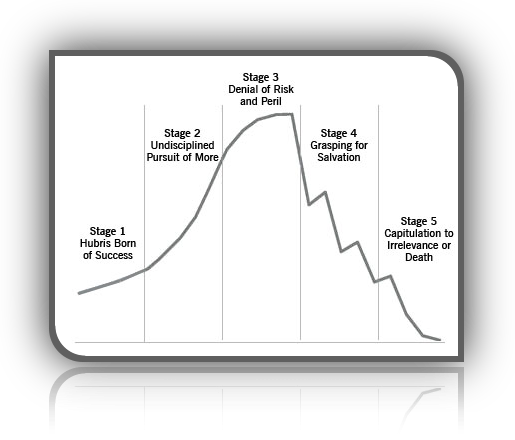
Deadly sins
Feeding problems and starving opportunities :::
Slaughtering tomorrow’s opportunity
at the altar of yesterday
Rather than thinking in terms of brands,
it might be more constructive to think
in terms of contribution and mission and purpose.
Apple ::: Sears ::: AT&T ::: IBM ::: GM ::: Exxon ::: HP
JC Penny ::: Sony ::: Xerox ::: Nokia ::: Kodak ::: Blockbuster ::: RadioShack
“Corporations once built to last like pyramids
are now more like tents.
Tomorrow they’re gone or in turmoil.
And this is true not only of companies in the headlines like …
Technology is changing very quickly,
as are markets and structures.
You can’t design your life
around a temporary organization.” — Peter Drucker

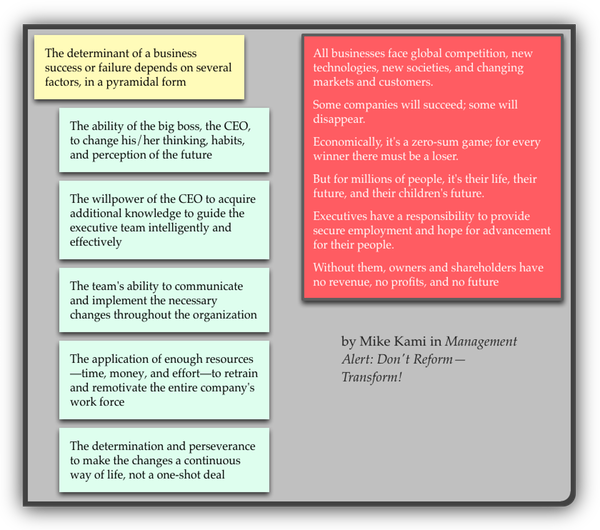
“If you never change your mind, why have one?” — Edward de Bono
Technology Is Wiping Out Companies Faster than Ever
Victims of success
The bright idea: The casualty rate is enormous
In our roles as consumers
we seek to further our interests
rather than that of a supplier.
We can switch when it suits our interests …
All our experience tells us that
the customer never buys
what the supplier sells.
Value to the customer
is always something fundamentally different
from what is value or quality to the supplier.
This applies as much to a business
as it applies to a university or to a hospital. — PFD
Marketing — inside - out OR outside - in
Every institution — and not only business — must build into its
day-to-day management four entrepreneurial activities that run in parallel.
These are conditions for survival today.
These entrepreneurial tasks differ from the more conventional management
roles of allocating present-day resources to present-day demands.
These entrepreneurial activities start with the outside
and are focused on the outside
And they repeat …
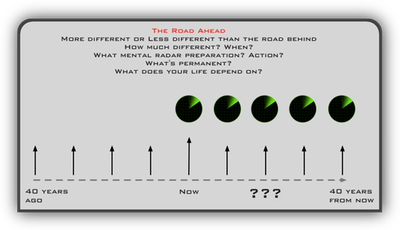
Regardless of the success of current endeavors,
an on going thought process is needed for making a different future
“Success always obsoletes the very behavior that achieved it.
It always creates new realities.
It always creates, above all,
its own and different problems.” — Peter Drucker
Customer’s unsatisfied wants may requires all kinds of dangerous liaisons — below

Reprise: This page provides a big picture, thinking landscape
for working through time …
It is a way to see and work beyond
current mental involvements — which is essential
for navigating a changing world
Some of the ideas are things to work toward,
some suggest event reactions, some provide
a blurry look at the world that surrounds us
at different points in time
All of it provides something to work with …
Connecting the dots

We can only work on, with and toward the “things”
on our active “mental radar.”
Today and TomorrowS
… and that’s why this page is so long, complex and challenging …
… just like the real world
As a person is going through the ideas here,
they can ask themselves:
“Is this an area in which I want to spend further time?”
Sometimes it may be very difficult to see the relevance connection
because the initial and perfectly valid human behavior
is to reflect back toward the past.
While the more useful mental gymnastics
may be to ask: “Will this area intersect
with my future life — in unexpected ways?”
What do these issues, these challenges mean for …
Larger ::: an alternative
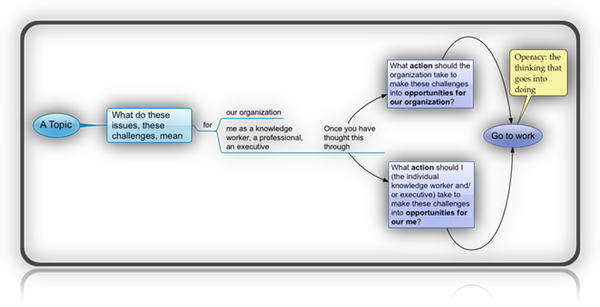
Dense reading and Dense listening and Thinking broad and Thinking detailed
Operacy — the thinking that goes into doing
Water logic vs. rock logic
At points on the page there is duplicated content
next to a different element. The purpose
is to make mental connections more apparent.
I have not done this for every connection.
A page search for important words may be
of some help — the word stem “surv”
Urban world: The shifting global business landscape
Navigating implies making adjustments — sometimes
major adjustments along the way.

A profoundly changing world implies
more than adjustments are needed — maybe leaps.
See organization life stories above
A changing world also implies the need for
continuous exploration, thinking, new and different
insights, horizons, attention focuses …
Are the 1950s, 1970s 1990s, 2010s … coming back?
Luther, Machiavelli, and the Salmon further down the page
The radar blips on this page are for …
Working on
working through time
Multiple unimagined futures and multiple radar sweeps — above.
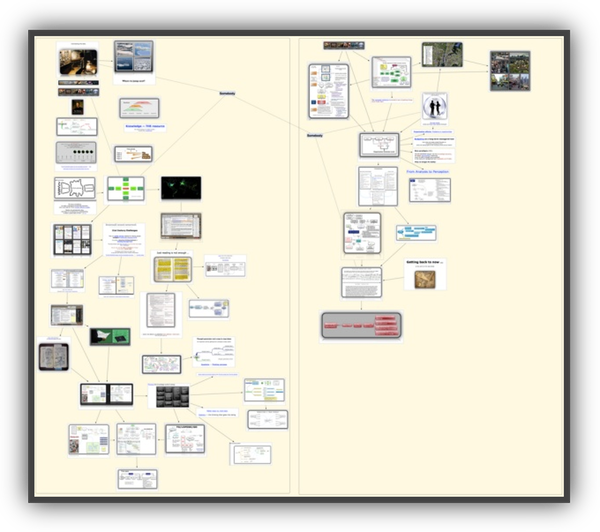
Larger view
We can only work on, with and toward the “things”
on our active “mental radar”
at any point on the timeline above.
At each point in time there is a reality that exists at that time.
The reality at any point reflects changes
that have taken place along the timeline …
There are major time usage and financial implications
in moving toward tomorrowS
We’re all making decisions
about invisible time usage areas
whether we know it or not.
FROM Feeding Yesterday and Starving Tomorrow
TO Feeding Tomorrow and Leaving Yesterday — PFD

“And while humanity can never really “master” the environment,
while we are always held within a tight vise of possibilities,
it is management’s specific job to make what is desirable
first possible and then actual.
Management is not just a creature of the economy;
it is a creator as well.
And only to the extent to which it
masters the economic circumstances, and
alters them by consciously directed action,
does it really manage.” — PFD
“Management’s concern and management’s responsibility are everything
that affects the performance of the institution and
its results—whether inside or outside,
whether under the institution’s control
or totally beyond it.” — Management’s new paradigm
“The function of organizations is to make knowledges productive” more
Part of the people challenge …
Just about everybody enters the world of work through
known day-to-day operating work. How could we ever acquire a
strategic, dynamic worldview from our beginning vantage points?

The unfolding time exploration on this page is different
from educational courses and functional specialties
because they don’t define organization futures.
An Internet search of ("scientific thought") AND technology AND
("fine arts") AND knowledge AND engineering
AND understanding using DEVONagent Pro
produced the following topic map
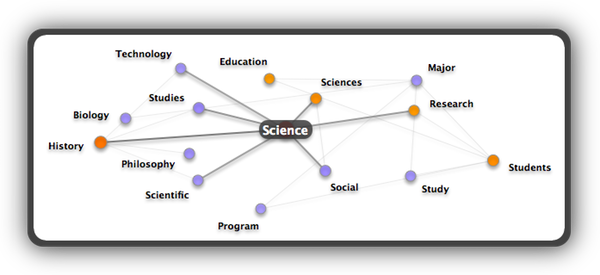
Everything is connected to everything else
Maybe Peter Drucker can help
Google rlaexp.com site search for Peter Drucker ::: A social/political ecologist
From The Economist ::: top of the food-chain
Druckerisms
Why Drucker Distrusted Facts (HBR blog) ::: Argument vs. Parallel Thinking
Going outside
The future is between our ears

All of the site blips and links create a larger
and more dynamic mental landscape.
The benefit is explained by competing patterns.
“We know only two things about the future.
It cannot be known.
It will be different from what exists now and from what we now expect”
— Chapter 10 Management, Revised Edition
Extrapolating yesterdayS is a fruitless attempt
to predict the future.
“Trying to predict the future
is like driving down a country road at night
with no headlights on and
looking out the back window” — Peter Drucker
Making the future (further down the page)
Despite the evidence to the contrary, it seems like everybody in the news
assumes the existing society and economy is permanent
and extrapolates them toward 2020 and 2030 — and here. Not good.
Organizations (and maybe individuals) need to be prepared
for the abandonment of everything they do?
They need to be organized
for constant change? (further down the page)
This page and site are a way to look beyond current mental involvements
and consider the roadS ahead …
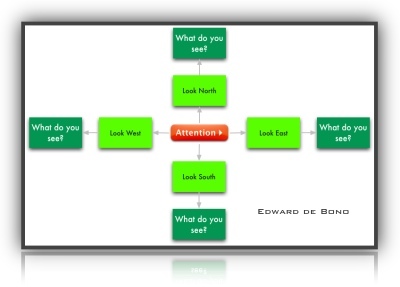
This page is a tool (an “action landscape or thoughtscape”)
rather than an article.
Looking for new horizons, action areas, things to stop doing, next steps,
next leaps and other “things” to work toward …
The looking involves repeated attention redirecting and competing patterns
and it leads to …
Invisible time usage decisions
There is a need to work on this when there is no apparent need.
Which radar blips (here and elsewhere), in what sequence, when, and how to remember … ?
The things on our radar
are the things we’ve paid attention to previously
that are still on our radar and that we can connect
to the current situation or something like that …
How does a person think about things
they aren’t already thinking about?
Mentally absorbed in working on the familiar
with the familiar in a familiar mental landscape
When we are embedded in doing something
we are blind to the changing world around us.
What about strategic planning? See corporate crisis later
Imagine someone in 1900, 1950 or 1970
working on strategic planning
In a genuinely changing world
it can be an enormous challenge just to figure out
what the challenge is …
THE TRANSFORMATION
Can America Compete? Strategies for economic revival
Later: Knowledge constantly making itself obsolete ::: Victims of success :::
The constellation that emerges from thinking along a brainroad
Economic stagnation and severe social tension from
failure to raise knowledge and service worker productivity

When the time comes to begin creating tomorrowS,
what mental radar content will be available?
(see thought collector below)
What will be needed?
When does the preparation start?
Will it already be too late?
Not conscientiously doing this kind of work
wrongly assumes that nothing is going to change …
In effect, it sabotages one’s fellow employees, organization, community …
Imagine the outcomes of someone in 1950, 1970, 1990, 2005
devoting all their energy
to what existed at the time
and what was on their radar at the time.
It is a very uneven landscape.
How do we keep our brain focused on the road ahead
and what’s next without it naturally slipping back
into the normal daily flow of events
that eventually lead to dead ends?

There’s no way to know
what someone is going to be doing in
ten or fifteen years.
The mostly Drucker radar blips below provide
top-of-the-food-chain launching points
for creating a game plan along the multiple radar sweeps
You’ll have something to work with that you didn’t have before.
Drucker: The Man Who Invented the Corporate Society
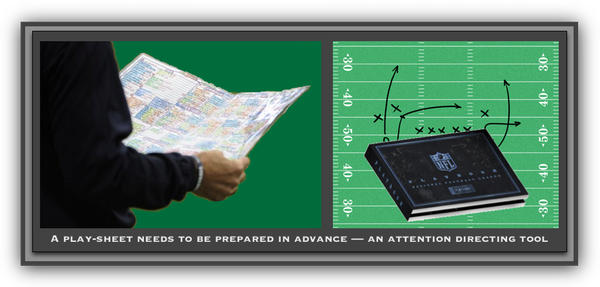
Working with the site is a way to integrate radar blips
into one’s radar sweep and time usage.
See the thought collector below


Working with the site
Site scope consists of a breadth of areas across time

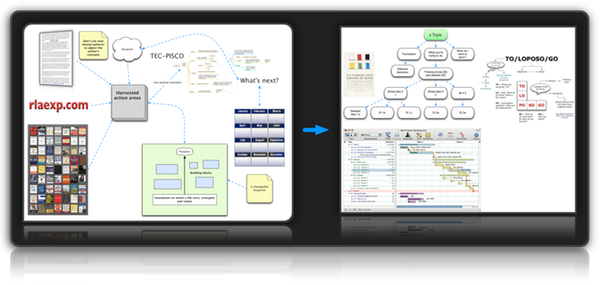
Larger
The image above illustrates a work approach. The left half illustrates the collection of radar blips and working with them. The right half illustrates topic work.
It might be a good idea to read through the page as fast as possible without exploring too many links. The links in this section might be an exception. Here is a more elaborate path
Serious tourists may want to map topic structures
- Set up a way to note areas of interest (see thought collector below)
- Explore and note
- It's important to explore with a mental radar sweep that extends beyond current mental involvements … Otherwise it's very difficult to get beyond the familiar (prisoner of the past)
- Attention directing: Look north, note what you see …
- Thinking, choices, decisions are determined by what we’ve seen …
- “Today perceptiveness is more important than analysis” — PFD
- We need ‘attention-directing tools’ for human perception
- We cannot see things unless we are prepared to see them …
- That is why analysis is a limited tool
- The ‘unitary’ nature of attention
- And one acts only upon what one is paying attention to …
- Major time usage and financial implications
- See the thought collector below and multiple radar sweeps above
- Finally, in a changing world we need to change what we’re paying attention to and we need a mechanism that makes us do it.
- Select areas of interest
- Work things out in time — on the road ahead (secret office).
All of this is on the site

Larger view of image above. Thought collector and idea mapping
Calendarization (working something out in time)
The actual results of action are not predictable

Larger view of image above

Organization actions: creating change to abandonment

Thought collector
List on the left = play-sheet candidate (image above)
Pages associated with each = the details (plays)
Content: clues to how the world works; trends; areas of work;
people; thoughts that shape the world …
See multiple radar sweeps on the road ahead image above
e.g., “Even the largest organization is unreal compared
to the reality of the environment in which it exists” — PFD
Which of the discreet thoughts between this point
and the top of the page
warrant a separate topic in the thought collector?
Each topic is a brain-address that can revisited at will.
… And one acts only upon what one is paying attention to …
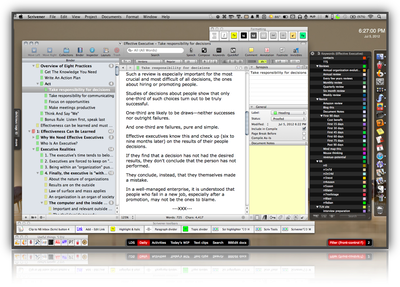
May be useful in learning and an annual review
We can only work on, with and toward the “things”
on our active “mental radar.”

Remember: the future is unpredictable + the multiple radar sweeps
and making the future
Challenge thinking and an alternative — operacy
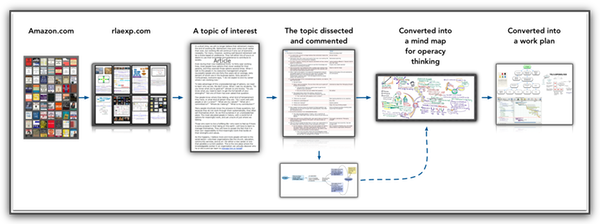
Dense reading and Dense listening and Thinking broad and Thinking detailed

Thought generator and a way to map ideas
An important tool for getting from concepts to daily action
and structuring where “things” fit
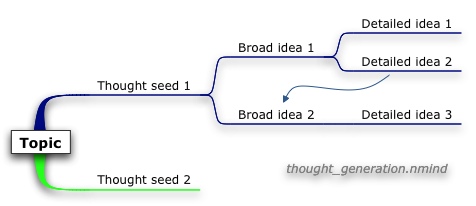
Thinking canvases
more on these tools below
To this point, time and attention have been covered.
Actually everything above and below involves
attention-directing and attention-flow.
This is necessary for working through time.

What needs to be on our radar
to create decisions
that will be effective on the road ahead?
“The small- or medium-sized business usually cannot afford much
by way of top management. But if it wants to grow,
it better make sure that well ahead of time
it develops the top management it will need when it has grown” — PFD
A distinction needs to be seen between top management and
C-level or C-suite titles.
Types of work: operating ::: top management ::: innovation
Right size ::: Knowledge and technology

Economic stagnation and severe social tension from
failure to raise knowledge and service worker productivity
When we are absorbed in routine operating work
how do we focus on the road ahead
in a changing, unpredictable world?
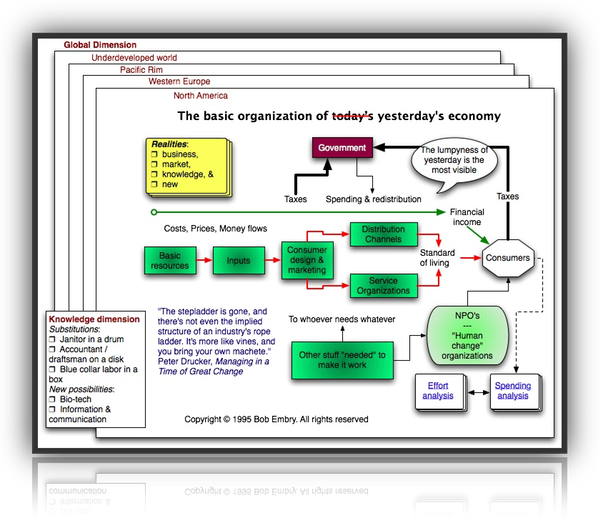
The structure of the U.S. economy
is remarkably different
from what everybody thinks
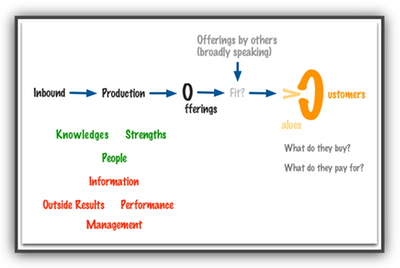
Larger view of the micro image above
Production ::: manufacturing (on the road ahead)
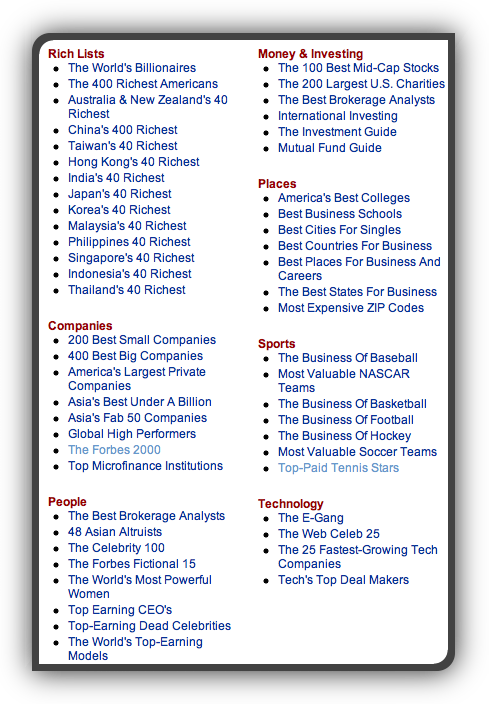

The center of modern society is the managed institution :::
Results exist only on the outside ::: Constantly pushing back the limitations :::
Making knowledge productive
It is society’s way of getting things done these days.
Why in a growing economy do we see dying organizations?
Management and the world’s work
Top Management: Tasks, Organization, Strategies still relevant?
The transformation (reprise)
What will be the content and structure
of tomorrow’s economy?
What knowledge specialties will be needed
to produce and distribute the “values”
people want and can afford?
How might this unfold in the future?
What can we currently see unfolding?
Urban world: The shifting global business landscape
Tomorrow: What will today’s capable knowledge person
be working on and where?
Who will work in new efforts?
«§§§»
Because the growth sector of a developed society in the 21st century
is most unlikely to be business—in fact, business
has not even been the growth sector
of the 20th century in developed societies.
A far smaller proportion of the working population in every
developed country is now engaged in business than it was a hundred years ago.
Then virtually everybody in the working population made his living
in economic activities (mostly farming).
The growth sectors in the 20th century in developed countries have been
in nonbusiness—in government, in the professions, in health care, in education.
In the 21st century that trend is going to continue with a vengeance.
So the nonprofit social sector is where management (and here) is today
most needed and where systematic, principled, theory-based management
can yield the greatest results fastest.
Just think of the enormous problems facing the world—poverty,
health care, education, international tension—and the need
for managed solutions becomes loud and clear.
— Management’s new paradigms
It’ll (health care) be a growth sector simply because health care and education
together will be 40 percent of the gross national product within twenty years.
Already, they’re at least a third.
Furthermore, as more and more services by government agencies
will be outsourced, it will make little difference
whether the organization which gets a contract to clean the streets
is for profit or not for profit.
It won’t be in the market economy.
If I could voice one comment on your magazine
and the present e-commerce and e-business-to-business concern altogether,
it’s so far focused on business.
Yet I think the greatest e-commerce impact
may be in higher education and health care.
— Managing in the Next Society
«§§§»
Knowledge, technology and information content …
Try a page search for each of the preceding words
From Analysis to Perception ::: Management’s new paradigm
The Next Society
Most of the other blips on this page
Everybody in 1950, 1970, 1990 … had assumptions …
Forbes: America's Most Miserable Cities 2013
Why weren’t the civic leaders
paying attention to the realities
of the basic economic foundations?
“What exists is getting old”
Economic stagnation and severe social tension from
failure to raise knowledge and service worker productivity
Complexity in the 21st century
“In any system as complex as the economy of a developed country,”
Drucker warned in The New Realities, “the statistically insignificant events,
the events at the margin, are likely to be the decisive events…
By definition they can be neither anticipated nor prevented.
They cannot always be identified even after they have had their impact.”
Practical Thinking ::: What Everybody Knows Is Frequently Wrong
The Lights in the Tunnel: What will the economy of the future look like? Where will advancing technology, job automation, outsourcing and globalization lead?
The New Digital Age: In an unparalleled collaboration, two leading global thinkers in technology and foreign affairs give us their widely anticipated, transformational vision of the future: a world where everyone is connected—a world full of challenges and benefits that are ours to meet and to harness …
The Ultimate Resource: Arguing that the ultimate resource is the human imagination coupled to the human spirit, Julian Simon led a vigorous challenge to conventional beliefs about scarcity of energy and natural resources, pollution of the environment, the effects of immigration, and the “perils of overpopulation.”
What needs doing around here?
A local view from Google Earth
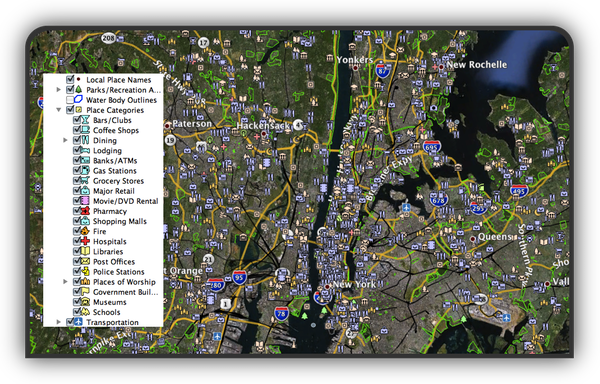
Along the road to Terra Alta
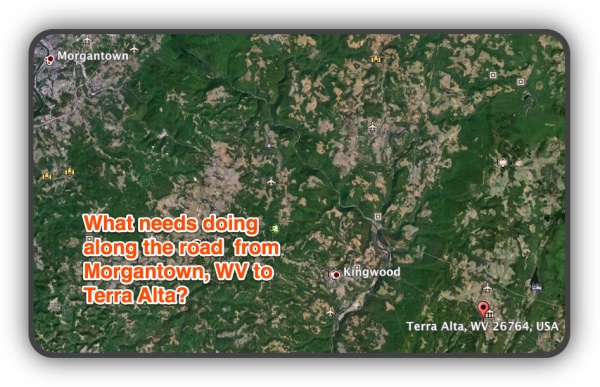
What can small, local organizations do as we move deeper
into the knowledge economy and knowledge society?

Urban world: The shifting global business landscape

Anthony Bourdain: Parts Unknown


The following blips are
examples of pages linked from
the site landscape view page
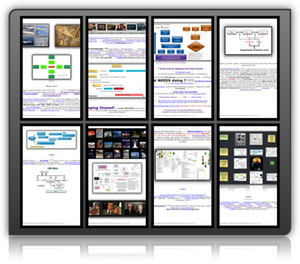
Remember the road ahead image with its multiple radar sweeps (above)
These blips are tools for
moving the brain around,
harvesting, and action —
over 500+ of them.
There are several timelines in play

The general sweep of history ::: organization life stories ::: individual life stories
Remember: the future is unpredictable + the multiple radar sweeps
and making the future
James Burke’s Connections

The managed institution — society’s way of getting things done.
Knowledge — THE resource
the central energy of a modern society —
it exists only in application
“That knowledge has become the resource,
rather than a resource,
is what makes our society “post-capitalist.”
This fact changes—fundamentally—the structure of society.
It creates new social and economic dynamics.
It creates new politics.
“The post-capitalist society is both
a knowledge society and a society of organizations,
each dependent on the other
and yet each very different in its concepts, views, and values.”
“In the knowledge society,
it is not the individual who performs.
The individual is a cost center
rather than a performance center.
It is the organization that performs.”
“It is the very nature of knowledge
that it changes fast and
that today’s certainties
will be tomorrow’s absurdities” — Peter Drucker
“The productivity of knowledge is going to be
the determining factor in the competitive position
of a company, an industry, an entire country” — PFD
more
The terms knowledge industries, knowledge work and knowledge worker
are nearly fifty years old.
They were coined around 1960, simultaneously but independently—
the first by a Princeton economist, Fritz Machlup,
the second and third by this writer.
Now everyone uses them, but as yet hardly anyone
understands their implications for human values and human behavior,
for managing people and making them productive,
for economics, and for politics.
What is already clear, however, is that the emerging knowledge society
and knowledge economy will be radically different
from the society and economy of the late twentieth century.
Chapter 4, Management, Revised Edition
… “For the major new insights in every one
of the specialized knowledges arise out of another,
separate specialty, out of another one of the knowledges.
Both economics and meteorology are being transformed
at present by the new mathematics of chaos theory.
Geology is being profoundly changed by the physics of matter;
archaeology, by the genetics of DNA typing;
history, by psychological, statistical, and technological analyses
and techniques.” Chapter 48, Management, Revised Edition
Peter observed that we are now in another critical moment:
the transition from the industrial to the knowledge-based economy …
We should expect radical changes in society
as well as in business.
“We haven’t seen all those changes yet,” he added.
Even the very products we buy will change drastically. …
He spent the better part of the next two hours defining and pulling this idea apart
(the application of knowledge to knowledge): the importance of
accessing, interpreting, connecting, and translating knowledge” more …
The End of Economic Man
Up to Poverty ::: The Vanishing East ::: The rise of new power centers :::
Urban world: The shifting global business landscape
A Century of Social Transformation ::: The priority tasks
Technology, Management and Society
Profits & Profitability
Management and the World’s Work
The New Society of Organizations
From Analysis to Perception — The New Worldview
Knowledge and Technology
Knowledge: Its Economics and Productivity
Management’s New Paradigms
The Next Society
All of this embedded within …
Glossary (wip)
Information — the organizing principle for work
A world organized by information
We know only two things about the future
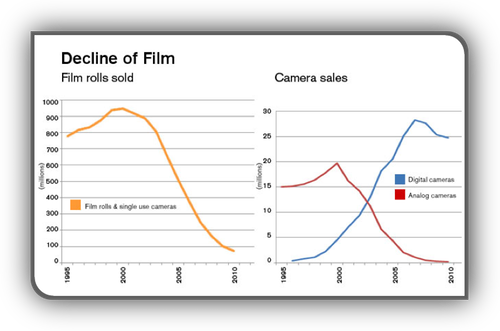
 Present situations (diagnosis ::: event reactions) Present situations (diagnosis ::: event reactions)
Consider the different situations of Kodak film vs. Eastman Chemical, RIM (Blackberry), Nokia, JC Penny, Sears, Sony, Panasonic …
Many of these organizations were not initially resource strapped — at one time they may have had plenty of financial resources and they didn’t lack people with high educational credentials (Nobel laureates, Ph.Ds, MBAs), high IQs, high performance ratings or long experience, facilities or the popular activities (“marketing”, “innovation efforts”, “strategic planning”, “quality” efforts, employee and management “development”) Who Says Elephants Can’t Dance?
What changed their fortunes? What were their reactions? How mentally prepared were they?
What else is their to worry about besides existing competition?
How much financial warning did they get before things “really” changed? In other words, at what point did their financial statements tell them they had a serious, life-threatening problem?
Would “Measuring Business Performance” and “A Scorecard for Management” in The Changing World of the Executive or “Company performance: five telltale tests” in Managing for the Future have been better predictors? See the decline of film above.
How were the various activities and efforts of these organizations connected to the contribution the organization delivered to the outside world — their customers? This is a clue for the “arrangement” of the world of tomorrows.
Was the aim of their people development efforts on target?
Why do so many of these have to go outside to find a CEO candidate?
One of the links on the main exploration page leads to Mike Kami’s Corporate Planning Process Manual (strategic planning). Mr. Kami was head of planning for both Xerox and IBM during their growth phases. His planning process didn’t prevent both of these organizations from being run over by a changing world.
Find “What market standing does it need to maintain leadership” on this page
Drucker on strategic planning (image) — taking the right risks. See chapter 11, Management, Revised Edition. More on uncertainty and risk
Innovation in the existing organization requires special effort
Once an enterprise or an industry has started to look back, turning it around is exceedingly difficult, if it can be done at all.
“CFOs deal with past numbers.
By the time they get them all parsed and pinned down, the numbers are often wrong.
In effect, CFOs are trying to steer companies by peering into the rearview mirror.
Past numbers do not have anything much to do with future numbers.
… snip, snip …
The accounting model is suffering from what philosophers call a deteriorating paradigm—it gets more and more complex to account for its lack of explanatory power.
… snip, snip …
In all fairness to accounting, it never was meant to predict value prospectively, only to record transactions retroactively.
… snip, snip …
The best an accountant can do is to extrapolate the past into the future, and unless one’s theory is that the future is going to be the same as the past, this technique is fraught with hazards.
This was Drucker’s point at the CEO conference in Seattle.
CEOs and entrepreneurs have to create the future, not relive the past.
The only way to effectively do that is with a theory of the business, which requires one to get outside of the four walls of the organization and connect with external reality — where all value is created.” — more (CEO)
The mental landscape is a critical factor. The surrounding topics on this page.
… In short, it (the modern organization) must be organized for constant change.
The society of organizations
The organization’s function is to put knowledge to work—on tools, products, and processes; on the design of work; on knowledge itself.
It is the nature of knowledge that it changes fast and that today’s certainties always become tomorrow’s absurdities
… snip, snip …
“For managers, the dynamics of knowledge impose one clear imperative: every organization has to build the management of change into its very structure. (See the change leader below)
On the one hand, this means every organization has to prepare for the abandonment of everything it does.
… snip, snip …
Indeed, organizations increasingly will have to plan abandonment rather than try to prolong the life of a successful product, policy, or practice—something that so far only a few large Japanese companies have faced up to
… snip, snip …
The need to organize for change also requires a high degree of decentralization.
That is because the organization must be structured to make decisions quickly.
And those decisions must be based on closeness—to performance, to the market, to technology, and to all the many changes in society, the environment, demographics, and knowledge that provide opportunities for innovation if they are seen and utilized.” — The New Society of Organizations and Managing in a Time of Great Change
See “From Analysis to Perception — The New Worldview”
Organizations in the post-capitalist society thus constantly upset, disorganize, and destabilize the community.
Forbes: America’s Most Miserable Cities 2013
Board membership (see “What businesses can learn from nonprofits” — below)
The bored board — refusing to serve
3 models of corporate accountability — Therefore, a model that maximizes the long-term wealth-producing capacity of the corporation, with strong metrics and an effective board of directors to hold top management accountable, seems advisable for U.S. corporations
 Managing the Small Business ::: Managing the Family Business: see December 28 and 29 in The Daily Drucker Managing the Small Business ::: Managing the Family Business: see December 28 and 29 in The Daily Drucker
- Growth requires investment
- Anticipate the financial structure and financial resources it will need
- Anticipate future information needs
- Sloughing off diversions
- The small- or medium-sized business usually cannot afford much by way of top management. But if it wants to grow, it better make sure that well ahead of time it develops the top management it will need when it has grown.
 What executives should remember What executives should remember
- The theory of the business
- Working on the theory of the business while still successful may result in creating a path to the next stage before the current stage drags the organization down — assumptions
- Managing for business effectiveness
- What businesses can learn from nonprofits
- The new society of organizations
- Management’s job in the modern organization is not to command. It is to inspire (Apple Inc.?).
- The information executives truly need (try searching this page for “information”)
- Managing oneself
- They are not employees, they are people
- What makes an effective executive? (see The Effective Executive below)
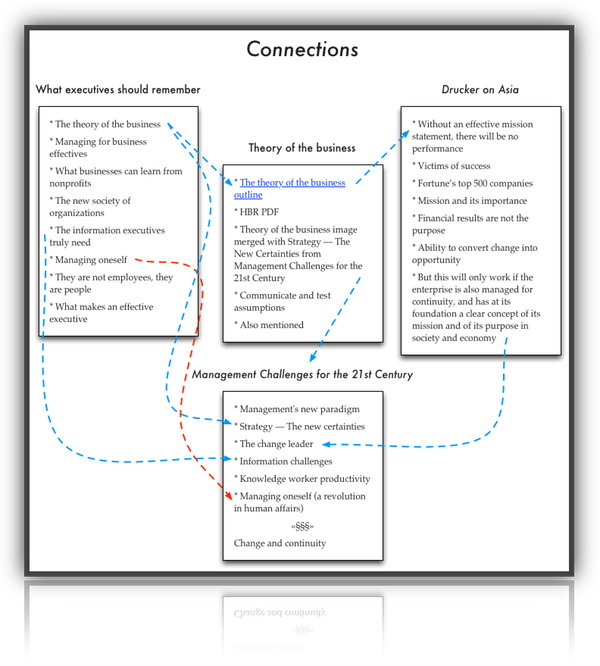
 The Changing World of The Executive The Changing World of The Executive
- A Scorecard for Management
- Measuring Business Performance
- Managing Capital Productivity
- The Delusion of Profits
- Good Growth and Bad Growth
- Inflation-Proofing the Company
- Aftermath of a Go-Go Decade
- Capital investment rather than consumption will have to become the engine of economic growth in the years ahead
The worldwide boom from the end of World War II until 1970 was largely fueled by consumer demand.
From now on, the center of economic growth will be in areas which require large and massive capital investments: energy; the environment; transportation; and increased food production
 Victims of success Victims of success
“Success always obsoletes the very behavior that achieved it. It always creates new realities. It always creates, above all, its own and different problems.” — Peter Drucker
 The shakeout The shakeout
 A first step may be to decide what to stop doing — abandonment. A first step may be to decide what to stop doing — abandonment.
Who wants an extrapolation of a 1920s or 1950s music player, black and white TV, rotary dial phone, clothing, window air conditioner … ?
Practicing weight control: abandon something before taking on something new.
… “every organization has to prepare for the abandonment of everything it does” … — The New Society of Organizations
 The failed strategy The failed strategy
 The five deadly sins The five deadly sins
 What Really Ails the U.S. Auto Industry (basic assumptions) What Really Ails the U.S. Auto Industry (basic assumptions)
 Organization efforts ::: Problems or Opportunities? Organization efforts ::: Problems or Opportunities?
 IBM Research IBM Research
As I said earlier, it has been well known for half a century that IBM has one of the most prolific and important scientific research laboratories in the world.
IBM has more Nobel laureates than most countries do, has won every major scientific prize in the world, and has consistently been the foundry from which much of the information technology industry has emerged.
However, the Research Division of the early 1990s was a troubled place.
My colleagues there saw the company being broken up into pieces and wondered where a centrally funded research organization would fit in an IBM that was being disaggregated.
When they heard I had decided to keep the company together, the collective sigh of relief that emanated from Yorktown Heights, New York (the headquarters of our Research organization) was almost audible.
One of the obvious but puzzling causes of IBM’s decline was an inability to bring its scientific discoveries into the marketplace effectively.
The relational database, network hardware, network software, UNIX processors, and more—all were invented in IBM’s laboratories, but they were exploited far more successfully by companies like Oracle, Sun, Seagate, EMC, and Cisco.
During my first year at IBM I probed frequently and deeply into the question of why this transfer of technology invention into market place performance had failed so badly.
Was it a lack of interest on the part of IBM researchers to deal with customers and commercial products?
It did not take long to realize that the answer was no.
The major breakdown was on the product side, where IBM was consistently reluctant to take new discoveries and new technologies and commercialize them.
Why?
Because during the 1970s and 1980s that meant cannibalizing existing IBM products, especially the mainframe, or working with other industry suppliers to commercialize new technology.
For example, UNIX was the underpinning of most of the relational database applications in the 1980s.
IBM developed relational databases, but ours were not made available to the fastest-growing segment of the market.
They remained proprietary to IBM systems.
From Who Says Elephants Can't Dance?: Leading a Great Enterprise through Dramatic Change
 Changing course: Changing course:
 Realities Realities
What exists is getting old
 Opportunities Opportunities
 Theory of the business and related Theory of the business and related
 Rethink and related Rethink and related
 Turnaround menu and related Turnaround menu and related
 General foundation for future directed decisions General foundation for future directed decisions
 Creating a True Whole Creating a True Whole
 People decisions — the ultimate — perhaps the only — control of an organization People decisions — the ultimate — perhaps the only — control of an organization
New job, new assignment, new task, or new challenge
 Harmonize the Immediate and Long-range Future Harmonize the Immediate and Long-range Future
What future?
 The future that has already happened The future that has already happened
“Economic growth can no longer come from either putting more people to work—that is, from more resource input, as much of it has come in the past—nor from greater consumer demand.
It can come only from a very sharp and continuing increase in the productivity of the one resource in which the developed countries still have an edge (and which they are likely to maintain for a few more decades): the productivity of knowledge work and of knowledge workers.” — more
It should be said that technology is no more “predictable” than anything else.
In fact, predictions of technology are, at best, useless and are likely to be totally misleading.
Jules Verne, the French science fiction writer of a hundred years ago, is remembered today because his predictions have turned out to be amazingly prophetic.
What is forgotten is that Jules Verne was only one of several hundred science fiction writers of the late nineteenth century—which indeed was far more the age of science fiction writing than even the present decade.
And the other 299 science fiction writers of the time, whose popularity often rivaled and sometimes exceeded that of Jules Verne, were all completely wrong.
More important, however, no one could have done anything at the time with Jules Verne’s predictions.
For most of them, the scientific foundations needed to create the predicted technology did not exist at the time and would not come into being for many years ahead.
For the businessman — but also for the economist or politician — what matters is not “prediction,” but the capacity to act.
And this cannot be based on “prediction.”
more on technology
 Knowledge and technology (from a “big picture” viewpoint — very important) Knowledge and technology (from a “big picture” viewpoint — very important)
 Knowledge is only knowledge in application Knowledge is only knowledge in application
Connect to “From Analysis to Perception — The New Worldview” below
… ”The knowledge of the knowledge society, precisely because it is knowledge only when applied in action, derives its rank and standing from the situation and not from its knowledge content.
What is knowledge, in other words, in one situation, such as the knowledge of Korean for the American executive posted to Seoul, is only information, and not very relevant information at that, when the same executive a few years later has to think through his company’s market strategy for Korea.
This, too, is new.
Knowledges were always seen as fixed stars, so to speak, each occupying its own position in the universe of knowledge.
In the knowledge society, knowledges are tools and, as such, dependent for their importance and position on the task to be performed.” — A Century of Social Transformation — Emergence of Knowledge Society
 … Now the assumption to start with is that the technologies that are likely to have the greatest impact on a company and an industry are technologies outside its own field. … Now the assumption to start with is that the technologies that are likely to have the greatest impact on a company and an industry are technologies outside its own field.
 And then there is the new “basic resource” information. It differs radically from all other commodities in that it does not stand under the scarcity theorem. On the contrary, it stands under an abundance theorem. And then there is the new “basic resource” information. It differs radically from all other commodities in that it does not stand under the scarcity theorem. On the contrary, it stands under an abundance theorem.
If I sell a thing, e.g., a book, I no longer have the book. If I impart information I still have it and can sell it again and again. What this means for economics is well beyond the scope of this paper—though it is clear that it will force us radically to revise basic economic theory.
But economics aside, managements had better understand what this means to them. Information does not pertain to any specific industry or business. Information also does not have any one end-use nor does any one end-use require a particular kind of information
One implication of this is that noncustomers are as important as customers, if not more important: because they are potential customers. There are very few institutions which supply as large a portion of a market as 30%. In other words, there are very few institutions where the noncustomers do not amount to at least 70% of the potential market. And yet very few institutions know anything about the noncustomers—very few of them even know that they exist, let alone know who they are. And even fewer know why they are not customers. Yet it is with the noncustomers that changes always start.
 … start with the assumption that there is no one given end-use for any product or service and that, conversely, no end-use is going to be linked solely to any one product or service … start with the assumption that there is no one given end-use for any product or service and that, conversely, no end-use is going to be linked solely to any one product or service
 The foundations have to be customer values and customer decisions on the distribution of their disposable income. It is with those that management policy and management strategy increasingly will have to start The foundations have to be customer values and customer decisions on the distribution of their disposable income. It is with those that management policy and management strategy increasingly will have to start
 Research lab, obsolete? New knowledge thoughts Research lab, obsolete? New knowledge thoughts
 more more
 Alliances, Collaborations, Outsourcing Alliances, Collaborations, Outsourcing
“Alliances of all kinds are becoming increasingly common, especially in international business: joint ventures; minority holdings (particularly cross-holdings, in which each partner owns the same percentage of the other); research and marketing compacts; cross-licensing and exchange-of-knowledge agreements; syndicates, and so on. The trend is likely to accelerate. Marketing, technology and people needs all push it”
Also see knowledge: its economics and productivity
…This means a radical change in structure for the organizations of tomorrow.
It means that the big business, the government agency, the large hospital, the large university will not necessarily be the one that employs a great many people.
It will be the one that has substantial revenues and substantial results—achieved in large part because it itself does only work that is focused on its mission; work that is directly related to its results; work that it recognizes, values, and rewards appropriately.
The rest it contracts out. — Post-Capitalist Society
… But now the traditional axiom that an enterprise should aim for maximum integration has become almost entirely invalidated.
One reason is that the knowledge needed for any activity has become highly specialized.
… snip, snip …
It is therefore increasingly expensive, and also increasingly difficult, to maintain enough critical mass for every major task within an enterprise.
And because knowledge rapidly deteriorates unless it is used constantly, maintaining within an organization an activity that is used only intermittently guarantees incompetence.
The second reason why maximum integration is no longer needed is that communications costs have come down so fast as to become insignificant.
… snip, snip …
This has meant that the most productive and most profitable way to organize is to disintegrate.
This is being extended to more and more activities. — Chapter 6, Management, Revised Edition
“Q: Now we need to know how managers can operate in the post-capitalist society.
A: You have to learn to manage in situations where you don’t have command authority, where you are neither controlled nor controlling.
That is the fundamental change.
Management textbooks still talk mainly about managing subordinates.
But you no longer evaluate an executive in terms of how many people report to him or her.
That standard doesn’t mean as much as the complexity of the job, the information it uses and generates, and the different kinds of relationships needed to do the work.
Similarly, business news still refers to managing subsidiaries.
But this is the control approach of the 1950s or 1960s.
The reality is that the multinational corporation is rapidly becoming an endangered species.
Businesses used to grow in one of two ways: from grass-roots up or by acquisition.
In both cases, the manager had control.
Today businesses grow through alliances, all kinds of dangerous liaisons and joint ventures, which, by the way, very few people understand.
This new type of growth upsets the traditional manager, who believes he or she must own or control sources and markets.” — Interview: The Post-Capitalist Executive
 GE’s Jeff Immelt on Leadership, Global Risk and Growth GE’s Jeff Immelt on Leadership, Global Risk and Growth
… “We still invest a billion dollars a year in training and education
We still invest to develop great people and help them learn.
But I’m extremely paranoid about it.
I think leadership has a very short shelf life, and so every few years, we look outside the company to see what others are doing: What’s Google doing?
What’s the U.S. Military Academy doing?
What are they teaching at the Communist Party School in Beijing?
What is McKinsey teaching its people?
I’m paranoid about keeping up-to-date with attracting and retaining great leaders from Bangalore to Boston and everywhere around the world.
We invest in people.
We demand performance.
We teach them what’s required.
We try to stay at the cutting edge, and we move people through experiences where they can learn and improve.
In the end, our success is proven based on where these people go.”
 The learning society is taking over The learning society is taking over
- Production a.k.a. manufacturing (see further down the page) is becoming knowledge intensive
- Knowledge is always specialized. Specialists remain specialists, becoming ever more skillful at interpreting the score — see illustration further down the page. Truly knowledgeable people tend by themselves to overspecialize, because there is always so much more to know
- Learn how to learn (learning for life not school)
- The most urgent learning and training must reach out to the adults
- But what kind of learning?
- This orchestra focus is the model for the leader of any knowledge-based organization
- more …
-
Learning
- Education
The assumption that a college degree automatically leads to positive social benefits needs to be examined. There is a statistical income connection but not much of a functional or operational connection. What to do?
… But schools are also becoming much too important not to be held accountable—for thinking through what their results should be, as well as for their performance in attaining these results.
To be sure, different school systems will give different answers to these questions.
But every school system and every school will soon be required to ask them, and to take them seriously.
We will no longer accept the schoolteacher’s age-old excuse for malperformance: “The students are lazy and stupid.”
With knowledge the central resource of society, lazy students or poor students are the responsibility of the school.
There are then only schools that perform and schools that do not perform. — Chapter 11, Post-Capitalist Society
 The Definitive Drucker The Definitive Drucker
… “Peter observed that we are now in another critical moment: the transition from the industrial to the knowledge-based economy … We should expect radical changes in society as well as in business. “We haven’t seen all those changes yet,” he added. Even the very products we buy will change drastically. … He spent the better part of the next two hours defining and pulling this idea apart (the application of knowledge to knowledge) : the importance of accessing, interpreting, connecting, and translating knowledge” more …
“Companies are increasingly organizing training efforts around application areas (e. g., benchmarking and continuous improvement teams) rather than subject disciplines or functions, thereby making it easier to apply new knowledge directly to rapidly changing tasks or opportunities”
Perils of the inside-out approach
 Managing in the Next Society Managing in the Next Society
Trends: The emergence of the Next Society and its new, and unprecedented, characteristics, especially:
 The global shrinking of the young population and the emergence of the new workforce The global shrinking of the young population and the emergence of the new workforce
 The steady decline of manufacturing as a producer of wealth and jobs The steady decline of manufacturing as a producer of wealth and jobs
 The changes in the form, the structure, and the function of the corporation and of its top management The changes in the form, the structure, and the function of the corporation and of its top management
Statistically, multinational companies play much the same part in the world economy as they did in 1913.
But they have become very different animals.
Multinationals in 1913 were domestic firms with subsidiaries abroad, each of them self-contained, in charge of a politically defined territory, and highly autonomous.
Multinationals now tend to be organized globally along product or service lines.
But like the multinationals of 1913, they are held together and controlled by ownership.
By contrast, the multinationals of 2025 are likely to be held together and controlled by strategy. Look here
There will still be ownership, of course.
But alliances, joint ventures, minority stakes, know-how agreements, and contracts will increasingly be the building blocks of a confederation.
This kind of organization will need a new kind of top management.
In times of great uncertainty and unpredictable surprises, even basing one’s strategy and one’s policies on these unchanging and basic trends does not automatically mean success.
But not to do so guarantees failure (survive).
Also: Moving Beyond Capitalism?; Capitalism vs. free markets.; The civil society (taking action to improve the lives of others); Why is the social sector growing in Japan, where the community has been so strong?; The Asian crisis; On Japan; On China; The changing world economy; The Rise of the Great Institutions; Control over the Fief; Needed autonomy; The Global Economy and the Nation-State; A true survivor; The nation-state afloat; Virtual money; Breaking the rules; Selling to the world; War after global economics; It's the Society, Stupid; A heretics' view; Descending from heaven; Elites rule; A policy about nothing; The social contract; It's the society, stupid; On Civilizing the City; Reality of rural life; The need for community
 Management Challenges for the 21st Century Management Challenges for the 21st Century
 Introduction Introduction
Those who do work on these challenges today, and thus prepare themselves and their institutions for the new challenges, will be the leaders and dominate tomorrow.
Those who wait until these challenges have indeed become “hot” issues are likely to fall behind, perhaps never to recover.
… snip, snip …
These challenges are not arising out of today.
… snip, snip …
In most cases they are at odds and incompatible with what is accepted and successful today.
We live in a period of PROFOUND TRANSITION and the changes are more radical perhaps than even those that ushered in the “Second Industrial Revolution” of the middle of the 19th century, or the structural changes triggered by the Great Depression and the Second World War.
… snip, snip …
For in many cases— … — the new realities and their demands require a REVERSAL of policies that have worked well for the last century and, even more, a change in the MINDSET of organizations as well as of individuals.
 Management’s new paradigms (below) Management’s new paradigms (below)
 Strategy: The new certainties Strategy: The new certainties
 Introduction Why Strategy? Introduction Why Strategy?
 The Collapsing Birthrate The Collapsing Birthrate
 The Distribution of Income The Distribution of Income
Industries, whether businesses or nonbusinesses, have to be managed differently depending on whether they are growth industries, mature industries or declining industries
… snip, snip …
In conclusion, institutions—businesses as well as nonbusinesses—will have to learn to base their strategy on their knowledge of, and adaptation to, the trends in the distribution of disposable income and, above all, to any shifts in this distribution. And they need both quantitative information and qualitative analysis.
 Defining Performance Defining Performance
 Global Competitiveness Global Competitiveness
Competition on the roadS ahead: … “One consequence of this is that every business must become globally competitive, even if it manufactures or sells only within a local or regional market. The competition is not local anymore—in fact, it knows no boundaries. Every company has to become transnational in the way it is run. … But in e-commerce there are neither local companies nor distinct geographies. Where to manufacture, where to sell, and how to sell will remain important business decisions. But in another twenty years they may no longer determine what a company does, how it does it, and where it does it” … source
All institutions have to make global competitiveness a strategic goal.
No institution, whether a business, a university or a hospital, can hope to survive, let alone to succeed, unless it measures up to the standards set by the leaders in its field, anyplace in the world.
One implication: It is no longer possible to base a business or a country’s economic development on cheap labor.
However low its wages, a business—except for the smallest and most purely local one, for example, a local restaurant—is unlikely to survive, let alone to prosper, unless its workforce rapidly attains the productivity of the leaders of the industry anyplace in the world.
This is true particularly in manufacturing.
For in most manufacturing industries of the developed world the cost of manual labor is rapidly becoming a smaller and smaller factor—one-eighth of total costs or less.
Low labor productivity endangers a company’s survival.
But low labor costs no longer give enough of a cost advantage to offset low labor productivity.
This (as already said in Chapter One) also means that the economic development model of the 20th century—the model first developed by Japan after 1955 and then successfully copied by South Korea and Thailand—no longer works.
Despite their enormous surplus of young people qualified only for unskilled manual work, emerging countries from now on will have to base growth either on technological leadership (as did the United States and Germany in the second half of the 19th century), or on productivity equal to that of the world leaders in a given industry, if not on themselves becoming the world’s productivity leaders.
The same is true for all areas: Design, Marketing, Finance, Innovation—that is, for management altogether.
Performance below the world’s highest standards stunts, even if the costs are very low and even if government subsidies are very high.
And “Protection” no longer protects, no matter how high the custom duties or how low the import quotas.
Still, in all likelihood, we face a protectionist wave throughout the world in the next few decades.
For the first reaction to a period of turbulence is to try to build a wall that shields one’s own garden from the cold winds outside.
But such walls no longer protect institutions—and especially businesses—that do not perform up to world standards.
It will only make them more vulnerable.
The best example is Mexico, which for fifty years from 1929 on had a deliberate policy of building its domestic economy independent of the outside world.
It did this not only by building high walls of protectionism to keep foreign competition out.
it did it—and this was uniquely Mexican in the 20th century world—by practically forbidding its own companies to export.
This attempt to create a modern but purely Mexican economy failed dismally.
Mexico actually became increasingly dependent on imports, both of food and of manufactured products, from the outside world.
It was finally forced to open itself to the outside world, since it simply could no longer pay for the needed imports.
And then Mexico found that a good deal of its industry could not survive.
Similarly, the Japanese tried to protect the bulk of their business and industry by keeping the foreigners out while creating a small but exceedingly competitive number of export industries—and then providing these industries with capital at very low or no cost, thus giving them a tremendous competitive advantage.
That policy too has failed.
The present (1999) crisis in Japan is in large part the result of the failure to make the bulk of Japanese business and industry (and especially its financial industries) globally competitive.
Strategy, therefore, has to accept a new fundamental.
Any institution—and not just businesses—has to measure itself against the standards set by each industry’s leaders anyplace in the world.
 The Growing Incongruence Between Economic Reality and Political Reality The Growing Incongruence Between Economic Reality and Political Reality
 The change leader The change leader
 One cannot manage change One cannot manage change
“One can only be ahead of it.
We do not hear much anymore about “overcoming resistance to change,” which ten or fifteen years ago was one of the most popular topics of management books and management seminars.
Everybody has accepted by now that “change is unavoidable.”
But this still implies that change is like “death and taxes”: It should be postponed as long as possible, and no change would be vastly preferable.
But in a period of upheavals, such as the one we are living in, change is the norm.
To be sure, it is painful and risky, and above all it requires a great deal of very hard work.
But unless it is seen as the task of the organization to lead change, the organization whether business, university, hospital and so on will not survive.
In a period of rapid structural change, the only ones who survive are the Change Leaders.
It is therefore a central 21st-century challenge for management that its organization become a change leader.
A change leader sees change as opportunity.
A change leader looks for change, knows how to find the right changes and knows how to make them effective both outside the organization and inside ”
 Change policies Change policies
 Organized abandonment Organized abandonment
 Organized improvement Organized improvement
 Exploiting success Exploiting success
Reports and meetings ::: staffing opportunities
 Creating change Creating change
The last policy for the change leader to build into the enterprise is a systematic policy of INNOVATION, that is, a policy to create change.
It is the area to which most attention is being given today.
It may, however, not be the most important one—organized abandonment, improvement, exploiting success may be more productive for a good many enterprises.
And without these policies—abandonment, improvement, exploitation—no organization can hope to be a successful innovator.
But to be a successful change leader an enterprise has to have a policy of systematic innovation.
And the main reason may not even be that change leaders need to innovate—though they do.
The main reason is that a policy of systematic innovation produces the mindset for an organization to be a change leader.
It makes the entire organization see change as an opportunity.
 Windows of opportunity Windows of opportunity
- Unexpected successes ::: unexpected failures ::: unexpected events
- Incongruities
- Process needs
- Changes in industry and market structures
- Changes in demographics
- Changes in meaning and perception
- New knowledge
This requires a systematic policy to look, every six to twelve months, for changes that might be opportunities
The unexpected success was Drucker’s favorite
… but if innovation is based on exploiting what has already happened—in the enterprise itself, in its markets, in knowledge, in society, in demographics and so on—it is far less risky
And this work should be organized as a regular part of every unit within the enterprise, and of every level of management.
Important to harvest and apply Dense reading and Dense listening and Thinking broad and Thinking detailed
 What not to do What not to do
 Piloting Piloting
 The change leader’s two budgets The change leader’s two budgets
 Change and continuity Change and continuity
 Making the future Making the future
“One thing is certain for developed countries—and probably for the entire world:
We face long years of profound changes.
The changes are not primarily economic changes.
They are not even primarily technological changes.
They are changes in demographics, in politics, in society, in philosophy and, above all, in worldview.
See these
Economic theory and economic policy are unlikely to be effective by themselves in such a period.
And there is no social theory for such a period either.
Only when such a period is over, decades later, are theories likely to be developed to explain what has happened.
But a few things are certain in such a period.
It is futile, for instance, to try to ignore the changes and to pretend that tomorrow will be like yesterday, only more so.
This, however, is the position that existing institutions tend to adopt in such a period—businesses as well as nonbusinesses.
It is, above all, the policy likely to be adopted by the institutions that were most successful in the earlier period before the changes.
They are most likely to suffer from the delusion that tomorrow will be like yesterday, only more so.
Thus it can be confidently predicted that a large number of today’s leaders in all areas, whether business, education or health care, are unlikely still to be around thirty years hence, and certainly not in their present form.
But to try to anticipate the changes is equally unlikely to be successful.
These changes are not predictable.
The only policy likely to succeed is to try to make the future.
Changes of course have to fit the certainties (which this book attempted to outline in the preceding chapter).
Within these restraints, however, the future is still malleable.
It can still be created.
To try to make the future is highly risky.
It is less risky, however, than not to try to make it.
A goodly proportion of those attempting to do what this chapter discusses will surely not succeed.
But, predictably, no one else will.” (survive?)
Making the future II
“The twenty-first century will surely be one of continuing social, economic, and political turmoil and challenge, at least in its early decades.
The Age of Social Transformations is not over yet.
And the challenges looming ahead may be more serious and more daunting still than those posed by the social transformations that have already happened, the social transformations of the twentieth century” — A Century of Social Transformation
 Information challenges Information challenges
 Knowledge worker productivity Knowledge worker productivity
 Managing oneself (a revolution in human affairs) Managing oneself (a revolution in human affairs)
 Innovation — from a “big picture” viewpoint (use harvesting — beware of experience) Innovation — from a “big picture” viewpoint (use harvesting — beware of experience)
“Innovative opportunities do not come with the tempest but with the rustling of the breeze” — PFD
Innovation creates a new dimension of performance
The test of an innovation is whether it creates value.
Innovation means the creation of new value and new satisfaction for the customer.
A novelty only creates amusement.
Yet, again and again, managements decide to innovate for no other reason than that they are bored with doing the same thing or making the same product day in and day out.
The test of an innovation, as well as the test of “quality,” is not “Do we like it?”
It is “Do customers want it and will they pay for it?”
“Innovation is not a technical term. It is an economic and social term. Its criterion is not science or technology, but a change in the economic or social environment, a change in the behavior of people as consumers or producers, as citizens, as students or as teachers, and so on.
Innovation creates new wealth or new potential of action rather than new knowledge.
This means that the bulk of innovative efforts will have to come from the places that control the manpower and the money needed for development and marketing, that is, from the existing large aggregation of trained manpower and disposable money —
existing businesses and existing public-service institutions.” — PFD
“Similarly, in business the successful companies are not those that work at developing new products for their existing line but those that aim at innovating new technologies or new businesses. As a rule it is just as risky, just as arduous, and just as uncertain to do something small that is new as it is to do something big that is new. It is more productive to convert an opportunity into results than to solve a problem—which only restores the equilibrium of yesterday” — PFD
Innovation in the existing organization requires special effort
Once an enterprise or an industry has started to look back, turning it around is exceedingly difficult, if it can be done at all.
Aiming high is necessary to offset things that don’t work out
… But if existing institutions cannot learn to innovate, the social consequences will be almost unbearably severe. — Managing for the Future
Systematic work outline that can be used for calendarization.
The Bright Idea
Innovations based on a bright idea probably outnumber all other categories taken together.
Seven or eight out of every ten patents belong here, for example.
A very large proportion of the new businesses that are described in the books on entrepreneurs and entrepreneurships are built around “bright ideas”: the zipper, the ballpoint pen, the aerosol spray can, the tab to open soft drink or beer cans, and many more.
And what is called research in many businesses aims at finding and exploiting bright ideas, whether for a new flavor in breakfast cereals or soft drinks, for a better running shoe, or for yet one more nonscorching clothes iron.
Yet bright ideas are the riskiest and least successful source of innovative opportunities.
The casualty rate is enormous.
Creativity discussions fit in here somewhere
 From computer literacy to information literacy From computer literacy to information literacy
Most CEOs still believe that it’s the chief information officer’s job to identify the information the CEO requires.
This is, of course, a fallacy.
... snip, snip ...
We are rebuilding organizations around information.
… snip, snip …
This, however, creates enormous problems.
When we learn to use information as a tool, we are learning what to use it for, what we need, in what form, when, from whom, and so on.
The moment you examine these questions, you realize that the information you need—the really important information—you cannot truly get from your information system.
Your information system gives you inside information.
But there are no results inside a business.
… snip, snip …
When we talk about the global economy, I hope nobody believes it can be managed.
… snip, snip …
This is why the enterprise of tomorrow is going to be very narrow in focus.
Diversification can work only if you have the information.
And you don’t have it if the competition can come in from Osaka without any warning.
We have so little information on the outside, on markets, on customers.
Nothing—as many people have learned the hard way—is changing faster than distribution channels.
And if you wait until you get the report, it’s way too late.
A “database,” no matter how copious, is not information.
It is information’s ore.
For raw material to become information, it must be organized for a task, directed toward specific performance, applied to a decision.
Raw material cannot do that itself.
Nor can information specialists.
They can cajole their customers, the data users.
They can advise, demonstrate, teach.
But they can no more manage data for users than a personnel department can take over the management of the people who work with an executive. — Managing In A Time Of Great Change
New Approaches to Information
… But neither of these officers knows one blessed thing about information …
The new information revolutions focus on the “I”
They ask, “What is the MEANING of information and its PURPOSE?”
And this is leading rapidly to redefining the tasks to be done with the help of information and, with it, to redefining the institutions that do these tasks — Information challenges in Management Challenges for the 21st Century
Chapter 43 Management, Revised Edition
 Landscape intel updates (who would work on these?) Landscape intel updates (who would work on these?)
 Razor blade reading Razor blade reading
 Try a page search for “information” and then “intelligence” in The Daily Drucker Try a page search for “information” and then “intelligence” in The Daily Drucker
Information has to be organized to test a company's assumptions about its theory of its business. Information has to be organized to challenge a company's strategy. The ultimate test of an information system is that there are no surprises.
 From Analysis to Perception — The New Worldview From Analysis to Perception — The New Worldview
In an information-based society, bigness becomes a “function” and a dependent, rather than an independent, variable.
In fact, the characteristics of information imply that the smallest effective size will be best.
“Bigger” will be “better” only if the task cannot be done otherwise.
Increasingly, therefore, the question of the right size for a task will become a central one.
All of them are needed, but each for a different task and in a different ecology.
The right size will increasingly be whatever handles most effectively the information needed for task and function
Where the traditional organization was held together by command and control, the “skeleton” of the information-based organization will be the optimal information system — he’s not talking about today’s computer systems. Clue
The following is from The Daily Drucker
Large organizations cannot be versatile.
A large organization is effective through its mass rather than through its agility.
Mass enables the organization to put to work a great many more kinds of knowledge and skill than could possibly be combined in any one person or small group.
But mass is also a limitation.
An organization, no matter what it would like to do, can only do a small number of tasks at any one time.
This is not something that better organization or “effective communications” can cure.
The law of organization is concentration.
Yet modern organization must be capable of change.
Indeed it must be capable of initiating change, that is innovation.
It must be able to move scarce and expensive resources of knowledge from areas of low productivity and nonresults to opportunities for achievement and contribution.
This, however, requires the ability to stop doing what wastes resources.
Internet activity ::: Where does the educated person fit?
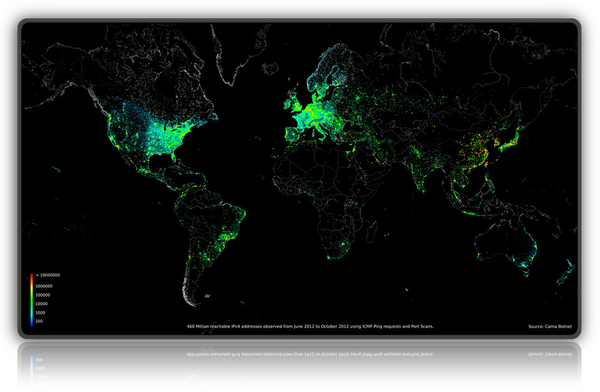
Since information knows no national boundaries,
it will also form new transnational communities of people
who, maybe with out ever seeing each other in the flesh,
are in communion because they are in communication
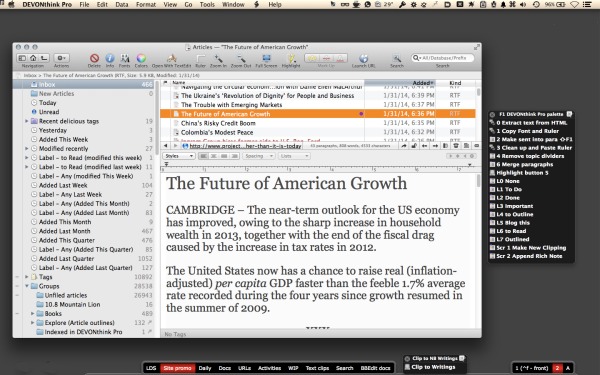
Larger view of image above
 Transnationalism, Regionalism, and Tribalism Transnationalism, Regionalism, and Tribalism
 Globalization Globalization
Trade Lessons from the World Economy
Inside-out or Outside-In?
“The customer never buys what you think you sell.
And you don’t know it.
That’s why it’s so difficult to differentiate yourself.” — Drucker
The world’s most popular cars: a new champ
“The Ford Focus isn’t the best-selling car in America; it’s not even in the Top 10. But around the world, especially in fast-growing markets in Asia, the sporty compact is growing in popularity, so much so that it is about to knock off the venerable Toyota Corolla as the world’s most popular car.
It’s been a record year for the auto industry, with global sales expected to top 80 million cars and trucks. Although European sales have been weak and China has slowed a bit, sales in the U.S. market have been robust, fed by pent-up demand. Analysts are forecasting U.S. sales of about 14.5 million units (less than 20 per cent of the market).
When it comes to crowning the best-selling cars, though, China, now the world’s largest automotive market, has the most clout. And in 2012, Ford and Toyota saw very different outcomes there. Ford has been investing heavily in China, and the Focus is one of 15 new models being introduced there over the next few years. Meanwhile, a long-simmering territorial dispute between Japan and China sparked a boycott of Japanese cars by Chinese consumers in the latter half of the year. As a result, Toyota’s sales in China fell about 25 percent below expectations” — Forbes
Selling to the World
“In the global economy, businesses are increasingly forced to shift from being multinational to being transnational.
The traditional multinational is a national company with foreign subsidiaries. These subsidiaries are clones of the parent company.
Most companies doing international business today are still organized as traditional multinationals. But the transformation into transnational companies has begun, and it is moving fast.
The products or services may be the same, but the structure is fundamentally different.
In a transnational company there is only one economic unit, the world.
Selling, servicing, public relations, and legal affairs are local.
But parts, machines, planning, research, finance, marketing, pricing, and management are conducted in contemplation of the world market. …
One of America’s leading engineering companies, for instance, makes one critical part for all of its forty-three plants worldwide in one location outside of Antwerp, Belgium—and nothing else. It has organized product development for the entire world in three places and quality control in four. For this company, national boundaries have largely become irrelevant.
The transnational company is not totally beyond the control of national governments. It must adapt to them. But these adaptations are exceptions to policies and practices decided on for worldwide markets and technologies.
Successful transnational companies see themselves as separate, nonnational entities. This self-perception is evidenced by something unthinkable a few decades ago: a transnational top management. …
The U.S. government is trying to counteract this trend by extending American legal concepts and legislation beyond its shores. …
Although the United States is still the world’s largest economic power—and likely to remain so for many years—the attempt to mold the world economy to American moral, legal, and economic concepts is futile.
In a global economy in which major players can emerge almost overnight, there can be no dominant economic power.
Nonetheless, there is certainly need for moral, legal, and economic rules that are accepted and enforced throughout the global economy. A central challenge, therefore, is the development of international law and supranational organizations that can make and enforce rules for the global economy.” — The Transnational Economy and Managing in the Next Society. Also see Drucker on Asia — A Dialogue Between Peter Drucker and Isao Nakauchi and Find “transnational” in Drucker books
 Drucker on Asia — A Dialogue Between Peter Drucker and Isao Nakauchi Drucker on Asia — A Dialogue Between Peter Drucker and Isao Nakauchi
“Drucker, who dominates their dialogue, emphasizes that developing nations don’t need government-to-government aid or grandiose World Bank projects but, instead, partnerships with private enterprises in industrial nations”
Lots more brain-addresses
 Post-Capitalist Society Post-Capitalist Society
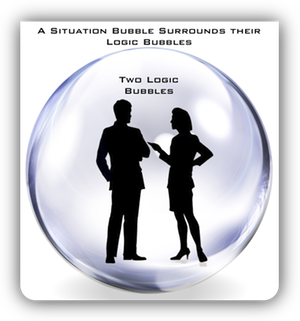
The logic bubble
(what are those crazy people thinking?)
 The Productivity of the New Work Forces The Productivity of the New Work Forces
“The new challenge facing the post-capitalist society is the productivity of knowledge workers and service workers.
To improve the productivity of knowledge workers will in fact require drastic changes in the structure of the organizations of post-capitalist society, and in the structure of society itself.
… Unless we can learn how to increase the productivity of knowledge workers and service workers, and increase it fast, the developed countries will face economic stagnation and severe social tension.
People can only get paid in accordance with their productivity.” more
 To Make Everybody a Contributor To Make Everybody a Contributor
There is a great deal of talk today about “entitlement” and “empowerment.”
These terms express the demise of the command and control-based organization.
But they are just as much terms of power and rank as the old terms were.
We should instead be talking about responsibility and contribution.
For power without responsibility is not power at all; it is irresponsibility.
Our aim should be to make people be more responsible.
What we ought to be asking is not, “What should you be entitled to?” but, “What should you be responsible for?”
The task of management in the knowledge-based organization is not to make everybody a boss.
It is to make everybody a contributor.
 Drucker’s time related books (the titles and chapter topics are major radar blips — important) Drucker’s time related books (the titles and chapter topics are major radar blips — important)
 Landscape intel updates (who would work on these?) Landscape intel updates (who would work on these?)
 Marketing (from a inside-out to outside-in) Marketing (from a inside-out to outside-in)
 Production ::: manufacturing (on the road ahead) Production ::: manufacturing (on the road ahead)
“A country that has the knowledge workers to design products and to market them will have no difficulty getting those products made at low cost and high quality” — Peter Drucker
There are no more service industries
“Most people make the mistake of thinking design is what it looks like. People think it’s this veneer — that the designers are handed this box and told, ‘Make it look good!’ That’s not what we think design is. It’s not just what it looks like and feels like. Design is how it works.” — Steve Jobs
What about what it’s designed to do?
“In other words, we are in the middle of a total re-think of manufacturing, in which blue-collar, industrial labor is being replaced by knowledge and information. A high labor coefficient in manufacturing production is actually a sign of obsolescence. No manufacturing operation, by the year 2000, can hope to be competitive if its blue-collar, direct labor costs are more than ten or twelve per cent. And this means that blue-collar manufacturing labor in developed countries will not be very much larger, as a proportion of the total work-force, than the farm population is today — and yet, as in farming, manufacturing will produce much more” — Drucker on Asia
 Leadership (no BS) Leadership (no BS)
 “I’ve seen a great many people who are exceedingly good at execution, but exceedingly poor at picking the important things. “I’ve seen a great many people who are exceedingly good at execution, but exceedingly poor at picking the important things.
They are magnificent at getting the unimportant things done.
They have an impressive record of achievement on trivial matters” — PFD
 Checking performance Checking performance
 Individual work lives Individual work lives
 Knowledge specialty that matters (who will be steering the bus on the road ahead?) Knowledge specialty that matters (who will be steering the bus on the road ahead?)
Knowledge is effective only if highly specialized.
“Generalists”—and this is what the traditional business enterprise, including the Japanese companies, tried to develop—are of limited use in a knowledge economy.
In fact, they are productive only if they themselves become specialists in managing knowledge and knowledge workers.
The knowledge worker, to repeat, differs from any earlier worker in two major aspects.
First, the knowledge worker owns the means of production and they are portable (to where? — bobembry).
Second, he or she is likely to outlive any employing organization.
Add to this that knowledge work is very different in character from earlier forms of work.
It is effective only if highly specialized
Knowledges by themselves are sterile. They become productive only if welded together into a single, unified knowledge. To make this possible is the task of organization, the reason for its existence, its function.
 Managing Oneself Managing Oneself
 Three kinds of intelligence (Niccolò Machiavelli) and people behaviors Three kinds of intelligence (Niccolò Machiavelli) and people behaviors
 The tasks of the manager :) The tasks of the manager :)
 Life-long self-development (Josh Abrams ::: You are responsible for allocating your life ::: Nobody else will do it for you ::: developing the person ::: developing the skill, competence, and ability to contribute ::: workmanship ::: Self-development becomes self-renewal when you walk a different path, become aware of a different horizon, move toward a different destination ::: means for self-development ::: keeping score on yourself ::: But, slowly, I improve—both in setting goals and in achieving results ::: Keeping score helps me focus my efforts in areas where I have impact and to slough off projects where nothing is happening, where I’m wasting not only my own resources but also those of my clients or students) Life-long self-development (Josh Abrams ::: You are responsible for allocating your life ::: Nobody else will do it for you ::: developing the person ::: developing the skill, competence, and ability to contribute ::: workmanship ::: Self-development becomes self-renewal when you walk a different path, become aware of a different horizon, move toward a different destination ::: means for self-development ::: keeping score on yourself ::: But, slowly, I improve—both in setting goals and in achieving results ::: Keeping score helps me focus my efforts in areas where I have impact and to slough off projects where nothing is happening, where I’m wasting not only my own resources but also those of my clients or students)
… “One implication of this is that individuals will increasingly have to take responsibility for their own continuous learning and relearning, for their own self-development and for their own careers. They can no longer assume that what they have learned as children and youngsters will be the “foundation” for the rest of their lives. It will be the “launching pad”—the place to take off from rather than the place to build on and to rest on. They can no longer assume that they “enter upon a career” which then proceeds along a pre-determined, well-mapped and well-lighted “career path” to a known destination—what the American military calls “progressing in grade.” The assumption from now on has to be that individuals on their own will have to find, determine, and develop a number of “careers” during their working lives” — Innovation and Entrepreneurship
“Remarkably few Americans are prepared to select jobs for themselves. When you ask, “Do you know what you are good at? Do you know your limitations?” they look you in the eye with a blank stare. Or they often respond in terms of subject knowledge, which is the wrong answer. When they prepare their résumés, they try to list positions like steps up a ladder. It is time to give up thinking of jobs or career paths as we once did and think in terms of taking on one assignment after another. We have to leap right over the search for objective criteria and get into the subjective—what I call competencies” — Managing in a Time of Great Change
 Career work plan development Career work plan development
 New job, new assignment, new task, or new challenge New job, new assignment, new task, or new challenge
 Thinking about a startup? ::: Reality Check Thinking about a startup? ::: Reality Check
 The second-half of one’s life The second-half of one’s life
 What do you want to be remembered for? What do you want to be remembered for?
 Thinking principles (the knowledge worker’s doing) Thinking principles (the knowledge worker’s doing)
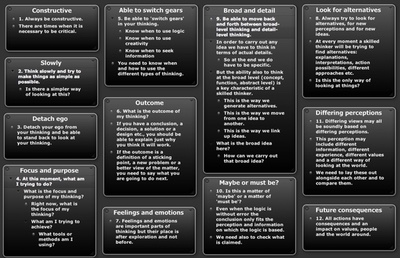
 The Effective Executive (getting the right things done) The Effective Executive (getting the right things done)
 Good intentions — the road to hell Good intentions — the road to hell
 Drucker on management (a shock to the system) Drucker on management (a shock to the system)
Page of major dynamic concepts
A way to make the brain see something and think about something that it couldn’t get to otherwise (attention)
- The center of modern society is the managed institution (the 800 lb. gorillas)
- Drucker viewed these as organs of society (how many organs are needed?)
- Organs are defined by their contribution, not what they do or how they do it
- Organs need to be constantly pushing back the limitations …
- Need to be managed by objectives derived from …
- The right definition of a manager is one who is responsible for the application and performance of knowledge
- The function of organizations is to make knowledges productive
- “The productivity of knowledge is going to be the determining factor in the competitive position of a company, an industry, an entire country.
- No country, industry, or company has any “natural” advantage or disadvantage.
- The only advantage it can possess is the ability to exploit universally available knowledge.
- The only thing that increasingly will matter in national as in international economics is management’s performance in making knowledge productive.” — only connect
-
Purpose and Objectives First
-
Strategy requires knowing “what our business is” and “what it should be”
-
Drucker also explained that “nothing may seem simpler or more obvious than to answer what a company’s business is …
-
And the right answer is usually anything but obvious …
-
“On the contrary,” Drucker wrote, “to raise the question and to study it thoroughly is most needed when a business is successful”
-
What is management?
- … Management must also enable the enterprise and each of its members to grow and develop as needs and opportunities change.
- Every enterprise is a learning and teaching institution.
- Training and development must be built into it on all levels—training and development that never stop
-
To P&G in 2001 [PG]: “Your problem is that you have attained your original objectives. This, in many ways, is the most dangerous situation you can be in.” Forbes
- Much more
“Concentration is the key to economic results. No other principles of effectiveness is violated as constantly today as the basic principle of concentration.”
MTRP Part Three: Top Management: Tasks, Organization, Strategies
Top Management is the directing, vision-setting, standard-setting organ.
As such it has specific tasks.
It requires its own organization.
And it faces specific top-management challenges of structure and strategy with respect to size and complexity, diversity and diversification, growth, change, and innovation.
Top-Management Tasks and Organization
Top-Management tasks differ fundamentally from the tasks of the other management groups.
They are multidimensional.
They are recurrent but intermittent.
They make different and often conflicting demands on personality and temperament.
There is, therefore, need so to structure the top-management job that both the objective tasks to be accomplished and the personalities of the people available are taken care of.
And there is need for providing top management with the stimulation and information it needs for its specific tasks.
Strategies and Structures
The job, task, and responsibilities of worker and foreman in the plant, key-punch operator and secretary in the office, metallurgist in the engineering lab, field salesman and branch manager of a bank or insurance company are little affected by size, complexity, growth, or diversity.
Even innovation has an effect on most people in an organization only after it has become accomplished fact.
But the structure, the behavior, the tasks, and the strategies of top management are profoundly molded by changes in size and complexity, by diversification, growth, and innovation.
And, in turn, top management—and only top management—can make the strategic decisions that lead to growth, diversification, or innovation.
The managerial strategies that relate to a company’s basic structure have received almost no attention.
They may, however, be of greater importance than strategies with respect to finances, product-development, or marketing on which the discussion has focused.
Size, diversity, complexity, growth, and innovation are, above all, managerial challenges and opportunities to top management and make managerial demands on it.
Using ignorance to your advantage
What management will we need on the road ahead?
Shortly after the end of the Korean War …
… “The only real advantage the United States has—perhaps for the next thirty or forty years—is a substantial supply of something that is not easily created overnight: knowledge workers.” … doing what?
Management and the world’s work
There is no point in asking which came first: the educational explosion of the last hundred years or the management that put this knowledge to productive use.
Modern management and modern enterprise could not exist without the knowledge base that developed societies have built.
But equally it is management, and management alone, that makes effective all this knowledge and these knowledgeable people.
The emergence of management has converted knowledge from social ornament and luxury into the true capital of any economy.
“That knowledge has become the resource,
rather than a resource,
is what makes our society “post-capitalist.”
This fact changes—fundamentally—the structure of society.
It creates new social and economic dynamics.
It creates new politics.
“High tech is living in the nineteenth century, the pre-management world.
They believe that people pay for technology. They have a romance with technology.
But people don’t pay for technology: they pay for what they get out of technology.” — The Frontiers of Management
New paradigms (CEO):
“AS WE ADVANCE deeper into the knowledge economy,
the basic assumptions underlying
much of what is taught and practiced
in the name of management are hopelessly out of date.
They no longer fit reality”
- Why assumptions matter
- Yet, despite their importance, the assumptions are rarely analyzed, rarely studied, rarely challenged indeed rarely even made explicit.
- For a social discipline such as management the assumptions are actually a good deal more important than are the paradigms for a natural science.
- The paradigm—that is, the prevailing general theory—has no impact on the natural universe.
- Whether the paradigm states that the sun rotates around the earth or that, on the contrary, the earth rotates around the sun has no effect on sun and earth.
- A natural science deals with the behavior of OBJECTS.
- But a social discipline such as management deals with the behavior of PEOPLE and HUMAN INSTITUTIONS.
- Practitioners will therefore tend to act and to behave as the discipline’s assumptions tell them to.
- Even more important, the reality of a natural science, the physical universe and its laws, do not change (or if they do only over eons rather than over centuries, let alone over decades).
- The social universe has no “natural laws” of this kind.
- It is thus subject to continuous change.
- And this means that assumptions that were valid yesterday can become invalid and, indeed, totally misleading in no time at all.
- Management is the specific and distinguishing organ of any and all organizations.
- Areas of greatest need in the 21st century?
- Management must look for the organization that fits the task.
- Organization is a tool for making people productive in working together
- A given organizational structure fits certain tasks in certain conditions and at certain times
- Universal principles of organization
- Individuals will have to learn to work at one and the same time in different organizational structures
- The executive of the future will require a toolbox full of organizational structures
- One does not “manage” people. The task is to lead people and make productive the specific strengths and knowledge of each individual.
- Changing composition of the work-force
- Their relationship, in other words, is far more like that between the conductor of an orchestra and the people who play the instruments
- What this means is that even full-time employees have to be managed as if they were volunteers
- What motivates—especially knowledge workers—is what motivates volunteers
- Managing people will become increasingly crucial in developed countries like the U.S. For the only competitive advantage developed countries can still hope to have is the productivity of their knowledge workers
- Neither technology nor end-use of a product is the correct foundation for management policy. Management must start with customer values and customer decisions as the basis for its strategy.
- The scope of management is not legal; it is operational, covering the entire economic chain. Look here
- The practice of management will have to he defined operationally rather than by political boundaries. Look here
- Finally, the results of any institution exist only on the outside.
- Bringing the world into the organization (from Inside-Out to Outside-In)
- Every organization today has to be designed for change as the norm and has to create change rather than just react to it
- Entrepreneurial activities start with the outside and are focused on the outside
- Any organization, however, that actually believes that management and entrepreneurship are different, not to mention incompatible, will soon find itself out of business
- Information technology may, so far, have actually done more damage to management than helped it, as is discussed in greater depth in chapter 33
- The traditional assumption that the inside of the organization is the domain of management includes the idea that management concerns itself with efforts, if not costs only
- For effort is the only thing that exists within an organization
- And, similarly, everything inside an organization is a cost center
- But the results of any institution exist only on the outside
- Indeed, the first task of management is to define what results and performance are in a given organization — and this, as anyone who has worked on this task can testify, is in itself one of the most difficult, one of the most controversial, but also one of the most important tasks
- It is, therefore, the specific function of management to organize the resources of the organization for results outside the organization
- §§§
- All our experience tells us that the customer never buys what the supplier sells
- Value to the customer is always something fundamentally different from what is value or quality to the supplier
- This applies as much to a business as it applies to a university or to a hospital
- See marketing above
“Management’s concern and management’s responsibility are everything that affects the performance of the institution and its results—whether inside or outside, whether under the institution’s control or totally beyond it.” — Management’s new paradigm
 The New Japanese Business Strategies The New Japanese Business Strategies
- Manufacturing work does not belong in a developed country
- Leadership throughout the developed world rests on control of brainpower
- The winner in a competitive world economy is going to be the firm that most effectively shortens the product life of its own products
- Zero-Defects Management
 Budgeting as a long-term managerial tool Budgeting as a long-term managerial tool
Starting with business objectives and especially marketing objectives
Productivity, strategy, strategic planning, growth …
An opportunities budget. The survival mechanism/hope. Part of a parallel opportunities work track: directional guidance concepts/thinking, people, money, follow-up …
Remember the mental movie and everything else here (the thought collector)
See present situations (diagnosis ::: event reactions)
Apple Inc.’s history
“For the manager the future is discontinuity.
And yet the future, however different, can be reached only from the present.
The greater the leap into the unknown, the stronger the foundation for the takeoff has to be.
The time dimension gives the managerial decision its special characteristics.” — Management, Revised Edition
 You can make all the plans you will, … all will likely come to naught, for “however carefully you plan for the future, someone else’s actions will inevitably modify the way your plans turn out.” — James Burke You can make all the plans you will, … all will likely come to naught, for “however carefully you plan for the future, someone else’s actions will inevitably modify the way your plans turn out.” — James Burke
Useful RADAR articles: http://delicious.com/bobembry and society, events, stuff happening is a partial listing from 28,000 article database. Razor blade reading
TLN conceptual resource file listing — topics and books

CEOs need to provide a “score”
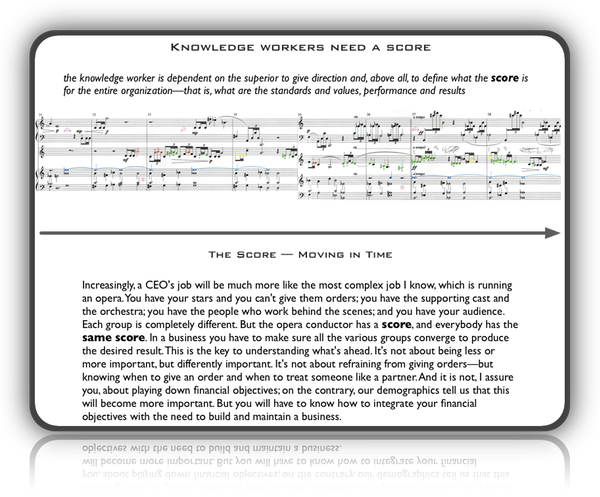
Specialists remain specialists,
becoming ever more skillful at interpreting the score … more

Just reading is not enough …
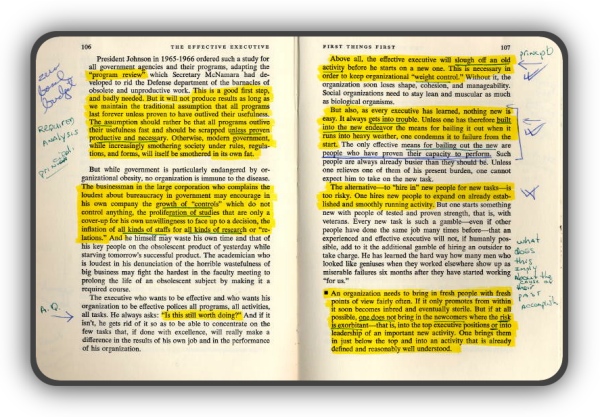
Harvesting and action thinking are needed …
What executives should remember
Innovation in the existing organization requires special effort
Innovation and Entrepreneurship ::: Piloting
The Transformation
An Effective Mission (the foundation for change management)
The New Corporation’s Persona
Making the future
Dense reading and Dense listening and Thinking broad and Thinking detailed
Larger view of image below

Water logic vs. rock logic
Operacy — the thinking that goes into doing
What do these issues, these challenges mean for …
::: an alternative

Thought generator and a way to map ideas
An important tool for getting from concepts to daily action

Questions ::: Thinking canvases
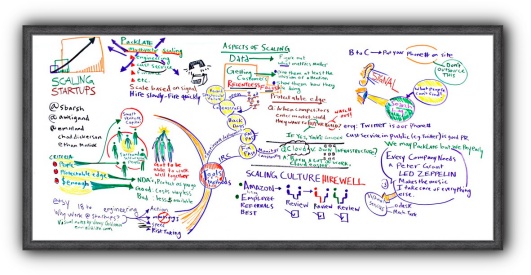
Connecting the dots

Even with excellent analytical tools, concepts, thinking habits …
there is a missing element — the “ecology” of the current time period …
It alters conclusions
A time span: Rolled film to digital to smart phones
Luther, Machiavelli, and the Salmon
an example with major implications.

What Everybody Knows Is Frequently Wrong ::: If You Keep Doing What Worked in the Past You’re Going to Fail ::: Approach Problems with Your Ignorance—Not Your Experience ::: Develop Expertise Outside Your Field to Be an Effective Manager ::: Outstanding Performance Is Inconsistent with Fear of Failure ::: You Must Know Your People to Lead Them ::: People Have No Limits, Even After Failure ::: Base Your Strategy on the Situation, Not on a Formula — A Class With Drucker: The Lost Lessons of the World's Greatest Management Teacher
A thought collector for keeping track of radar blips and time investment work
An attention collecting and attention directing tool

May be useful in learning and an annual review
We can only work on, with and toward the “things”
on our active “mental radar.”
Remember: the future is unpredictable + the multiple radar sweeps
and making the future
Part of the action thinking (mission, … objectives … how) involves making connections.
Maybe to something in the thought collector …
and certainly to knowledge

Larger

How else can people prepare for the
twists and turns on the road ahead?
What’s in their thought collector
We can only work on, with and toward the “things”
on our active “mental radar.”
“Managers are synthesizers
who bring resources together
and have that ability to “smell” opportunity and timing.
Today perceptiveness is more important than analysis.
In the new society of organizations,
you need to be able to recognize patterns
to see what is there
rather than what you expect to see.”
— Interview: Post-Capitalist Executive
Information executives need: going outside ::: razor blade reading

more complete version of the process

Thinking along a brainroad
The mental movie

Perils of the inside-out approach
A thinking tool kit from The Definitive Drucker
at a point in time
… embedded in a timescape …
Luther, Machiavelli, and the Salmon
Up to Poverty ::: Emancipation :::
The Vanishing East ::: The rise of new power centers :::
The Manager and the Moron
Urban world: The shifting global business landscape :::
… not knowing how to connect their knowledge
leads toward … ?
Doing business in a Lego World
How to get here?
Drucker on Asia
or
The New Japanese Business Strategies
* Manufacturing work doesn't belong in a developed country
* Leadership throughout the developed world
rests on control of brainpower
* The winner in a competitive world economy
is going to be the firm
that most effectively shortens
the product life of its own products
* Zero-defects management
There are major time usage and financial implications
We’re all making decisions
about invisible time usage areas
whether we know it or not.
FROM Feeding Yesterday and Starving Tomorrow
TO Feeding Tomorrow and … Yesterday — PFD
We can only work on, with and toward the “things”
on our active “mental radar.”
How will the people in your organization
integrate what’s needed into their lives?
While there is adequate remaining time …
“Managers are synthesizers
who bring resources together
and have that ability to “smell” opportunity and timing.
Today perceptiveness is more important than analysis.
In the new society of organizations,
you need to be able to recognize patterns
to see what is there
rather than what you expect to see.”
— Interview: Post-Capitalist Executive
Information executives need: going outside ::: razor blade reading
Connecting the dots

What if his cork board is viewed as radar screen?
The elements on the cork board could be considered radar blips.
His brain is doing a radar sweep
looking for patterns and connections
with a purpose.
What’s the next action?

Just about everybody enters the world of work through
known day-to-day operating work. How could we ever acquire a
strategic, dynamic worldview from our beginning vantage points?
Thought collector ::: Multiple radar sweeps ::: A systematic process is needed
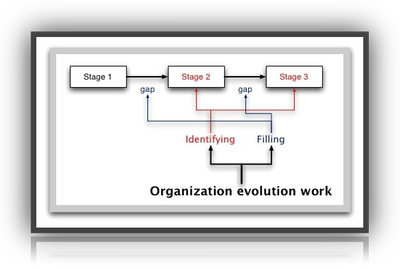
Budgeting as a long-term managerial tool
How does one keep oneself focused on
constantly pushing forward,
while not losing sight of the changing world around them?

Jump to Getting Back to Now

Summary to this point

A radar system for working through time
Changing world ::: Organization life stories ::: Individual life stories
Areas of work ::: Process ::: Thinking about thinking about it
A systematic way to move beyond routines and yesterday
When the time comes to begin working on tomorrowS
what mental radar content will be available? Repeat
Economic stagnation and severe social tension from
failure to raise knowledge and service worker productivity
The social consequences of
existing institutions not learning to “really” innovate
What Drucker management
will we need from here on out … ?
“AS WE ADVANCE deeper into the knowledge economy,
the basic assumptions underlying much of what is taught
and practiced in the name of management
are hopelessly out of date. They no longer fit reality”
Management’s new paradigms
All our experience tells us that
the customer never buys
what the supplier sells.
Value to the customer is always something fundamentally different
from what is value or quality to the supplier.
This applies as much to a business as it applies to a university or to a hospital.
Organize the resources of the organization for results outside the organization
Innovation in the existing organization requires special effort
Multiple radar sweeps: yesterdayS and tomorrowS
Additional important notes
are at the bottom of the page

Getting back to now …
at any point on the road ahead

Some mental preparation is needed for dealing with
the unexpected — success, failure, event.
Does the action best reside in the area of
the theory of the business, an exploitation,
a window of opportunity for a major innovation or
a need for market focus in the new venture.
And what strategy is most appropriate?
Chaotics: The Business of Managing and
Marketing in the Age of Turbulence
Organization efforts: Problems or opportunities
Bonus thought: time spans

When the time comes to begin something new
what will be available?
When is when? ::: What triggers when? ::: Who’s involved?
Thought collectors and their contents
We can only work on, with and toward the “things”
on our active “mental radar.”
at each of the multiple radar sweeps
The site is free to use
Ways to pay it forward
Donations ::: Sponsorships ::: Opening doors
Want some help getting started?
… before handing off to someone else. Evangelists, Attention directors
Thought collection setup ::: Thinking canvases ::: Bread crumb trails
People development
The site’s modular content makes it possible
to design special purpose pages with links to related topics.
Pay it forward?
Donations: Please click the button below to make a donation through PayPal.
Other forms of PayPal payment besides donations
rlaexp.com’s purpose is to provide a big picture thinking landscape for navigating our changing world — a world in profound transition.
There are 500+ pages inter-weaving management, leadership, organization evolution, the evolving content and structure of society, knowledge, technology, career evolution, education, learning, marketing, production, innovation, entrepreneurship, thinking, software tools, information challenges, concepts to daily action … through time. Any time someone is engaged in decision thinking they need a “foundation for future directed decisions.” ©
rlaexp.com is largely inspired by the work of Peter Drucker and a few others.
The site provides a “menu” for identifying important “things” to work toward that largely go unseen.
We can only work on, with and toward the “things” on our active “mental radar.”

In a changing world, we need a way to repeatedly look beyond current mental involvements.
We need a way to think about things we aren’t already thinking about at multiple points in time. Waiting for a crisis is one way to accomplish this, but surely there are better ways.
rlaexp.com’s uniquely broad landscape is designed to meet this challenge.
TomorrowS can’t be reached by today’s activities or thinking. Examples constantly flow through the news.
Who in 1950, 1970, 1990, 2000 … had an adequate future facing radar?
Why would today be any different?
Where and how we spend our time matters — a world in constant flux.
I’m trying to provide this exploration and thinking landscape to help people figure out what to do as we move deeper into the 21st century: a knowledge society, a society of organizations, and a network society.
America’s future depends on this awareness, ability and effective action.
It depends on younger generations having access to this dynamic type thinking and doing something effective. rlaexp.com provides the access and a work approach model.
Just about everybody enters the world of work through known, routine, day-to-day operating work at a point in time. It never seems to occur to nearly anybody that there could be anything else. How could we ever acquire a strategic, dynamic worldview from our beginning vantage points?
Pretending that tomorrow is going to be like yesterday is damaging.
Everybody has a vested interest in this.
For the site to remain available your support is needed. Your support helps with the books, software, web site hosting, and the time devoted to publicizing and enhancing the work approach available on rlaexp.com.
Who do you know that might be interested in working with me on spreading site usage and enhancement?
For the right kind of people, rlaexp.com provides the elements of a future facing consulting or mentoring practice. Contact info is near the bottom of most pages.

Notes
The content, the exploration, harvesting and action processes along with the thinking about thinking about it that we’ve just explored are aimed at providing a broad landscape and concrete work approach in multiple situations at multiple points in time.
This is a menu of time usage decisions with major financial implications.
These are decisions for creating the next chapterS in an organization’s or individual’s life story the way the iPhone was a new chapter in the Apple™ story — which continues to evolve.
By extrapolation, that makes it about the future of the developed world.
This future focus needs to be worked on when there is no obvious need.
There is a constant flow of organization crisis stories running through the news and they are almost all related to invisible time usage decisions.
We can only work on, with and toward the “things”
on our active “mental radar.”
A well stocked though collector and radar sweeps are needed.
If you buy Drucker’s reasoning on the dynamics of knowledge things are going to get more complex and thereby, more dangerous.
Repeatedly working though this page is a way to re-direct attention from current mental involvements at each radar sweep along the road ahead and generate new brainroadS.
Try tracing the brainroadS that constitute Apple’s™ history …
This site is a tool that can be shared with others. Somehow they need to be encouraged to do more than a page scroll. What pages did they visit? What did they harvest? How will they remember?
Working on this is a way to get beyond the day to day flow of events that eventually leads to a dead end. While a person is working on this they are doing something non-routine. Hopefully they are cautious about using their experience which relates mostly to different situations and the road behind. See using ignorance to your advantage and mindsets
Figuring out a way to introduce this process within an organization will require some choreography thinking and will have to evolve with needs and opportunities. Finding people willing to be attention directors or evangelists might be a start.
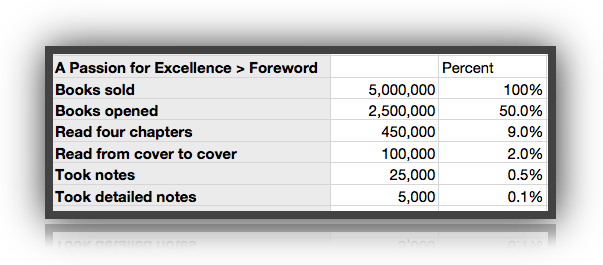
table above: Tom Peter’s observations on purchasers of In Search of Excellence.
Info was printed in A Passion for Excellence.
Just getting someone to work out a topic in time will help in their horizon building. This can substitute for expensive management or leadership courses.
REPRISE: Working through such a landscape is more than a one time process.
It brings one’s attention back to brain addresses that are basically invisible.
Such as the ideas in Luther, Machiavelli, and the Salmon or innovation in the existing organization
Second, third, fourth … visits will reveal new worldviews …
Drucker Quotations
“That knowledge has become THE resource, rather than a resource, is what makes our society “post-capitalist.”
This fact changes — fundamentally — the structure of society.
It creates new social and economic dynamics.
It creates new politics.
“The productivity of knowledge is going to be the determining factor in the competitive position of a company, an industry, an entire country”
“Knowledge is only knowledge in application”
“It is the very nature of knowledge that it changes fast and that today’s certainties will be tomorrow’s absurdities”
“Every organization has to prepare for the abandonment of everything it does”
“The modern organization must be organized for constant change”
“In a period of rapid structural change, the only ones who survive are the Change Leaders.”
“Success always obsoletes the very behavior that achieved it. It always creates new realities. It always creates, above all, its own and different problems.”
“The customer never buys what the supplier sells.
Value to the customer is always something fundamentally different from what is value or quality to the supplier.
This applies as much to a business as it applies to a university or to a hospital.”
“What everybody knows is frequently wrong”
“Those who keep doing what worked in the past are going to fail”
“Approach problems with ignorance—not experience”
A question:
At each radar sweep on the road ahead: how many billions of people on the planet are taking advantage of an organization’s specialized knowledge on a daily basis?
How can an organization expect to survive without the top power holder having a similar landscape awareness and action approach?
This page and its links aren’t nearly the entirety of the site
We can only work on, with and toward the “things”
on our active “mental radar.”
A well stocked though collector and radar sweeps are needed.
Difficulties of living in a changing world
 How does a person think about things they aren’t already thinking about? How does a person think about things they aren’t already thinking about?
 When we are embedded in doing something we are likely blind to the profoundly changing world around us. When we are embedded in doing something we are likely blind to the profoundly changing world around us.
 How do we keep our brain focused on the real road ahead and what’s next without it naturally slipping back into the normal daily flow of events that eventually lead to dead ends? Beware assumptions How do we keep our brain focused on the real road ahead and what’s next without it naturally slipping back into the normal daily flow of events that eventually lead to dead ends? Beware assumptions
 There’s no way to know what someone is going to be doing in ten or fifteen years. There’s no way to know what someone is going to be doing in ten or fifteen years.
 Just about everybody enters the world of work through known day-to-day operating work. Just about everybody enters the world of work through known day-to-day operating work.
 How could we ever acquire a strategic and dynamic worldview from our beginning vantage points? How could we ever acquire a strategic and dynamic worldview from our beginning vantage points?
 When the time comes to begin creating tomorrowS, what mental radar content will be available? When the time comes to begin creating tomorrowS, what mental radar content will be available?
 There is a need to work on this when there is no apparent need. There is a need to work on this when there is no apparent need.
 Otherwise, it sabotages one-self and one’s fellow employees, organization, community … Otherwise, it sabotages one-self and one’s fellow employees, organization, community …

Links to explore before initial fast read
 Thought collector Thought collector
 Annual review Annual review
 The customer never buys what you think you sell The customer never buys what you think you sell
 Perception more important than analysis: strategic ::: attention — preparing to see ::: sixteen different angles Perception more important than analysis: strategic ::: attention — preparing to see ::: sixteen different angles
 Secret office Secret office
Thinking …

… at different points in time

 Attention directing and flow — preparing to see Attention directing and flow — preparing to see
 Creating competing patterns Creating competing patterns
 News (just a quick scan) News (just a quick scan)
 Urban world: The shifting global business landscape Urban world: The shifting global business landscape
 Why Drucker distrusted facts Why Drucker distrusted facts
 Argument vs. parallel thinking Argument vs. parallel thinking
 Information and thinking ::: Dense reading and dense listening Information and thinking ::: Dense reading and dense listening
 Thinking broad and thinking detailed Thinking broad and thinking detailed
 Using ignorance to your advantage Using ignorance to your advantage
 Challenge thinking ::: an alternative Challenge thinking ::: an alternative
 Operacy — the thinking that goes into doing Operacy — the thinking that goes into doing
 Only connect Only connect
Thought generator and a way to map ideas
An important tool for getting from concepts to daily action

Questions ::: Thinking canvases

 Statistical abstract Statistical abstract
 Special librarians Special librarians

 Organization efforts ::: Problems or Opportunities? Organization efforts ::: Problems or Opportunities?
 How to guarantee non-performance How to guarantee non-performance
 Knowledge specialty Knowledge specialty
 New job, assignment … New job, assignment …
 Individual work lives Individual work lives
 What makes an executive effective What makes an executive effective
 Drucker on leadership Drucker on leadership
 Leadership Leadership

 The transformation The transformation
 Economic stagnation Economic stagnation
 Four entrepreneurial activities that run in parallel ::: True marketing Four entrepreneurial activities that run in parallel ::: True marketing
 Knowledge and technology Knowledge and technology



To create a rlaexp.com site search, go to Google’s site ↓
Type the following in their search box ↓
your search text site:rlaexp.com


Copyright 2001 2005 2007 2010 2011 2012 2013 2014 2015 2016 2017 © All rights reserved | bobembry | bob embry | “time life navigation” © | “life TIME investment system” © | “career evolution” © | “life design” © | “organization evolution” © | “brainroads toward tomorrows” © | “foundations for future directed decisions” © | #rlaexpdotcom © | rlaexpdomcom ©
rlaexp.com = real life adventures + exploration
#rlaexpdotcom introduction breadcrumb trail …
|


![]()